 Directly off the boat and immediately into trouble. 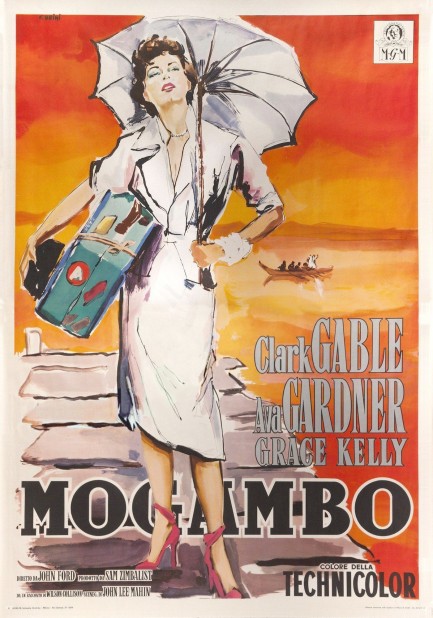 
We chose the header for this post because there's a movie called White Mischief, which we watched recently, about Brits in Africa, and it has an amusing line where a character surveys the morning and says, “Oh God, not another fucking beautiful day.” The two pieces of Italian promo art above for the set-in-Africa movie Mogambo might make you say, “Oh God, not another fucking beautiful Italian poster.”
These were painted by Ercole Brini, who we've never featured before but who is another of the many virtuosic artists from Italy that toiled for the movie studios. Whenever we think about the sad loss of painted cinematic poster art, the Italians are who come to our minds. We just don't think there's any doubt at this point—they were the best. Not that it's a competition. Amazing posters with interestingly local aesthetic attributes came from everywhere.
We'll try to feature more from Brini later, and if you're curious about Mogambo it's—of course—another movie about Africa turning various white northerners into cynical, shambling husks of their supposedly better former selves. Those husks are Clark Gable, Ava Gardner, and Grace Kelly. It opened in the U.S. in 1953 and premiered in Italy this week in 1954. Have a look here if you want to know more, and maybe here.
 It was the Whisper heard from coast to coast. 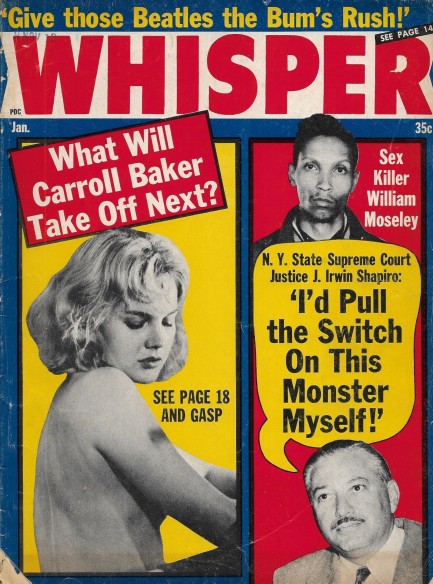
Above is a cover of the tabloid Whisper from January 1965, with actress Carroll Baker, convicted murderer Winston Moseley, and New York judge J. Irwin Shapiro starring on the front. But before we get into the magazine, we want to share the good news that our longtime scanning problems are fixed. We didn't get a new scanner, though. We got a new computer—a Mac Studio with plenty under the hood. It's quicker than the old Mac, but it also changed the functionality of the scanning interface. The whole process runs differently, and is about three times faster now. So you'll be seeing more magazines in the future. Turning back to Whisper, Winston Moseley—who editors call William for some reason—was America's villain of the moment for the murder of Catherine Genovese, who he stalked, stabbed with a hunting knife, then found again where she had taken refuge in a building, and finished her off. Additionally, Moseley was a necrophiliac. He raped his victims—of which there were three total—post-mortem. Of the trio of victims Genovese is the one that's remembered today because her murder sparked a national reckoning about the relationship between citizens and the police, as well as life in big cities, because the press reported that thirty-eight people had seen the crime happening but had done nothing. As it turned out, that number was wildly inaccurate, but never let the truth get in the way of perfectly cooked, juicy tabloid outrage. A quote appeared in nearly every story about the murder: “I didn't want to get involved.” New York City—where the crime occurred—and other metropolitan centers were criticized as uncaring places. Author Harlan Ellison, who at that time was writing urban crime fiction, weighed in, saying, “not one of [the witnesses] made the slightest effort to save her, to scream at the killer, or even to call the police.” Peak outrage was achieved by New York State Supreme Court Justice J. Irwin Shapiro when he expressed a desire to execute Moseley himself. In the end, Moseley wasn't executed at all. He died in prison in 2016 at age eighty-one.
Elsewhere in Whisper, you'll notice that the magazine is—unsurprisingly, given the time period and nature of the publication—antagonistic toward gay men, as demonstrated by the panel with the blaring text: “Who's Queer Asked the Peer?” But what is a surprise is that later in the issue the editors run a detailed piece on transvestites and transsexuals, and the approach is very different than the contempt shown toward homosexuality. As we've pointed out many times before, mid-century tabloids had a deep interest in trans issues. The story is titled, “A Doctor Answers What Everyone Wants To Know About Sex Change Operations.” The tone is as follows:
The condition he referred to was the common plight of all male transsexuals. Physically he was a man, but emotionally and personality-wise he was a woman, a condition that made it difficult to find successful employment, and to live at all happily. Fortunately, in his case, he had a lawyer and a wise judge who were able to help him in his wish to go to Europe for a sex change operation so that his body could be brought into greater harmony with his mind, and enable him to work and live with a degree of happiness he had never known before.
That's respectful—if not even compassionate—for a 1965 publication considered lowbrow by sophisticated readers. Is it a paradox that the magazine could be so evil toward gay men, yet so civil toward transsexuals? We think so, and we'd love to know the thought process behind it. While we're puzzling that out, you may want to move on to Whisper's slate of celebrity news. Everyone from Romy Schneider to Ernest Borgnine get their due exposure. We've uploaded the magazine's “Behind the Whispers” feature, so you can get the dish on a few Hollywood stars. Please enjoy.
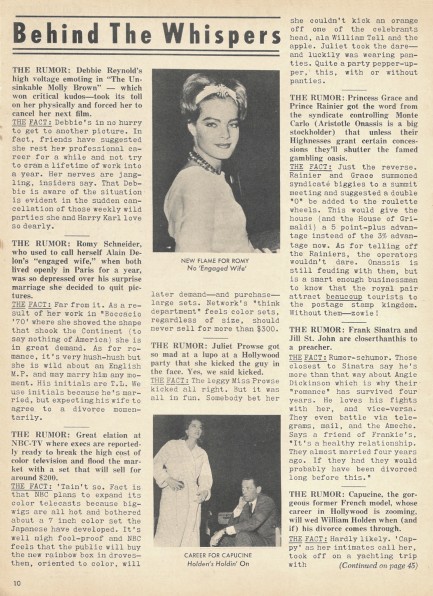  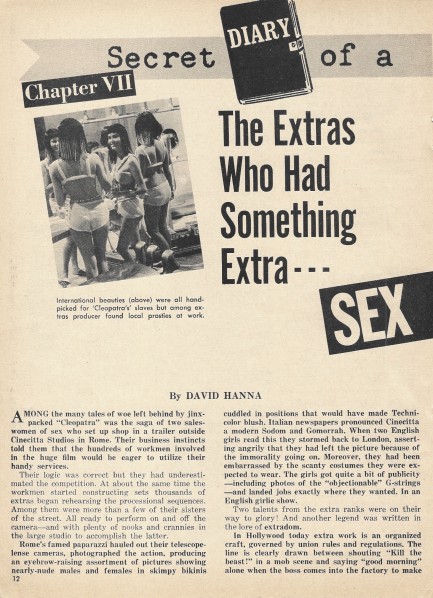 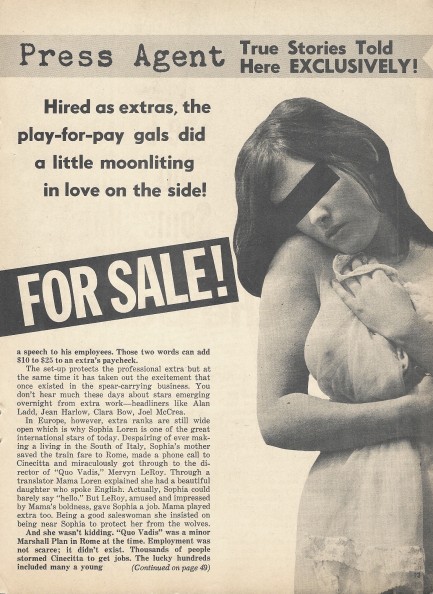 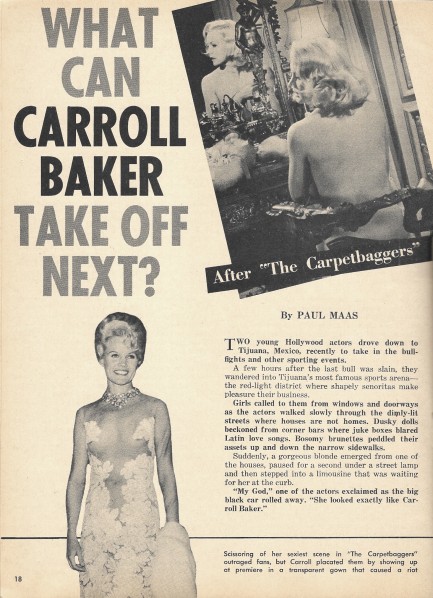 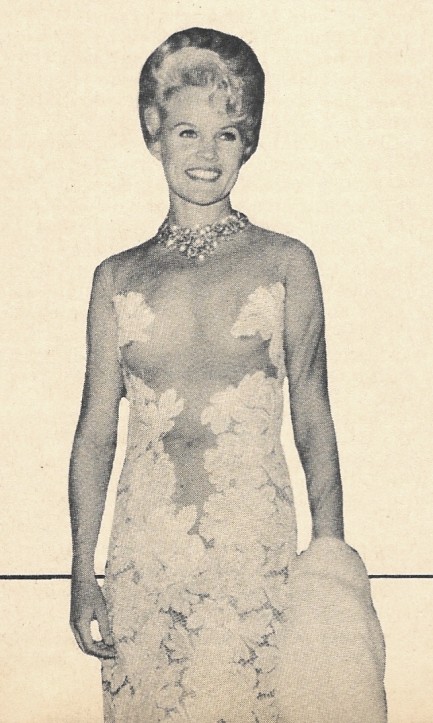 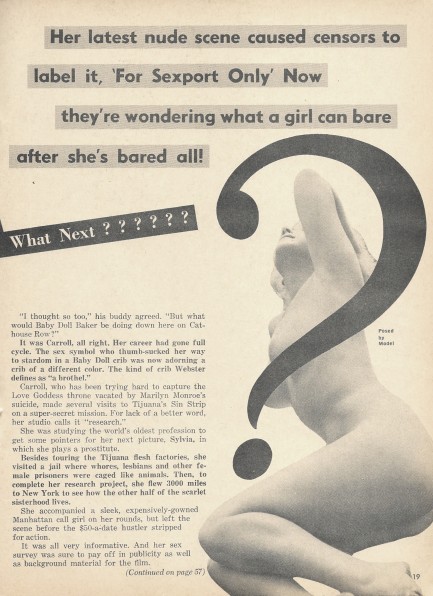 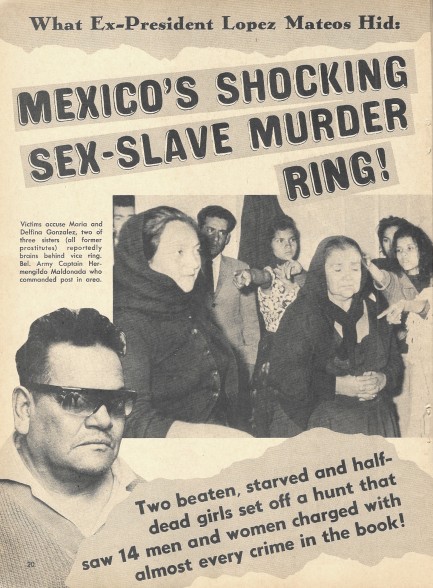 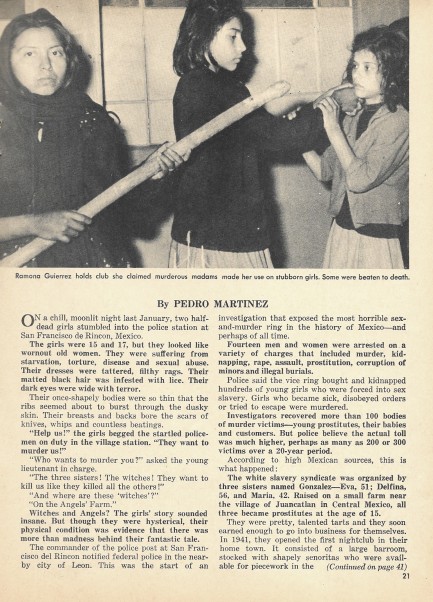 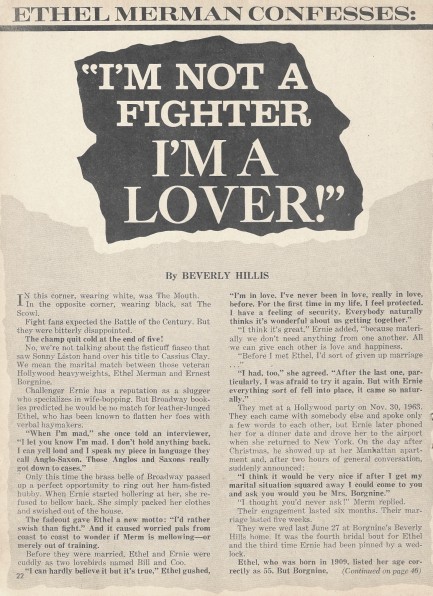 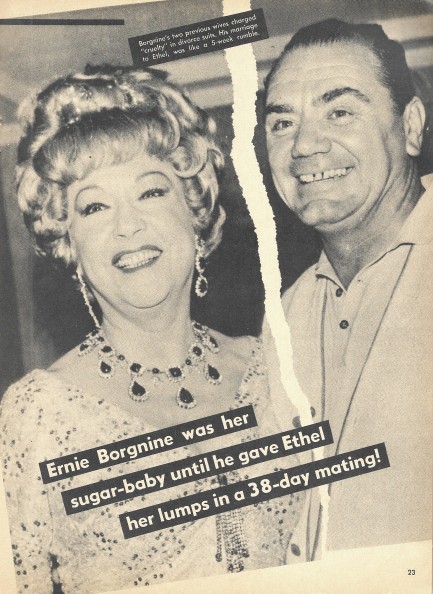 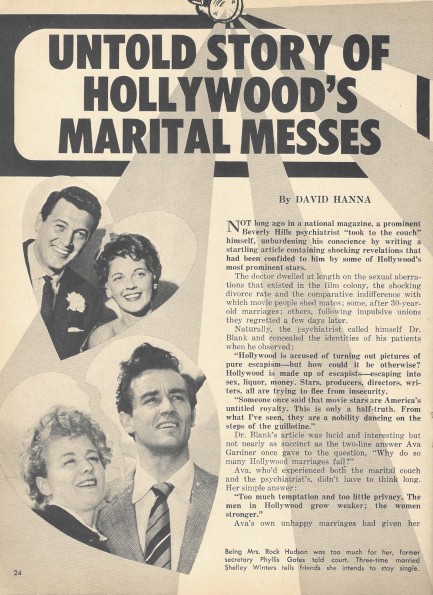 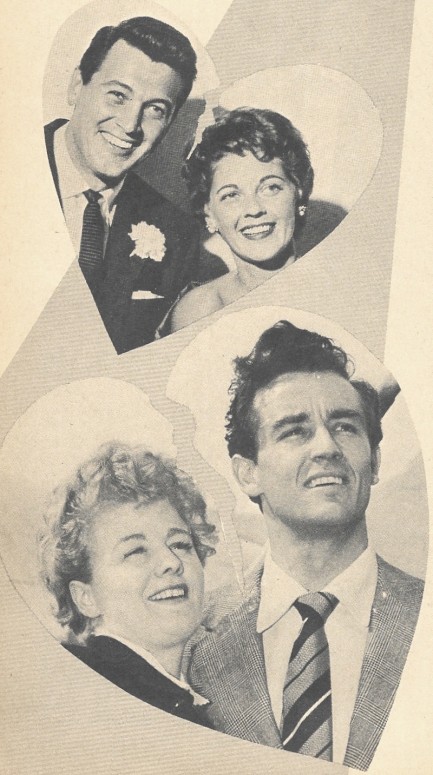 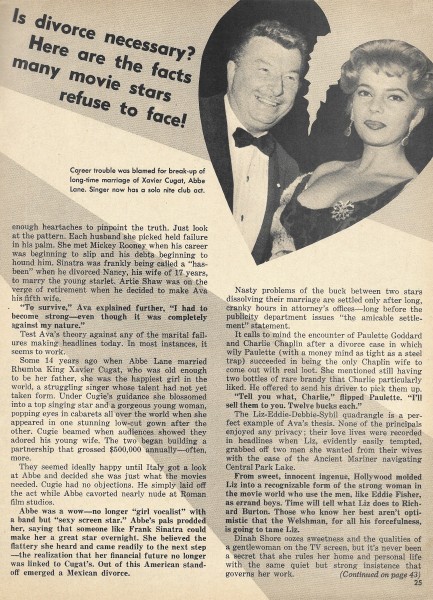 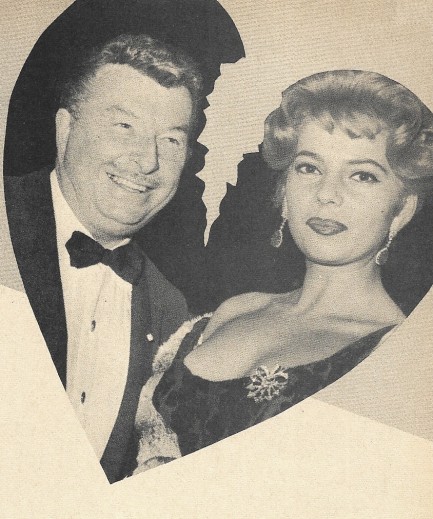 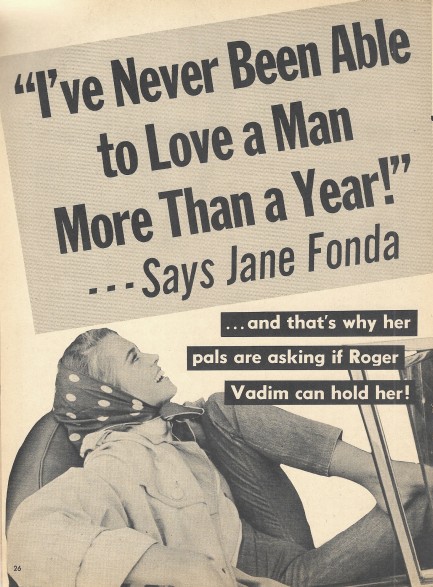 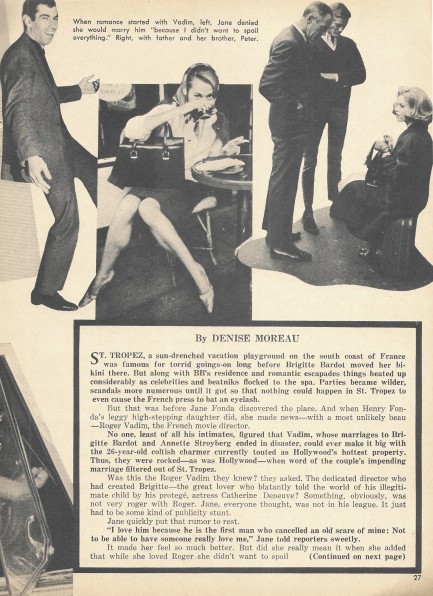 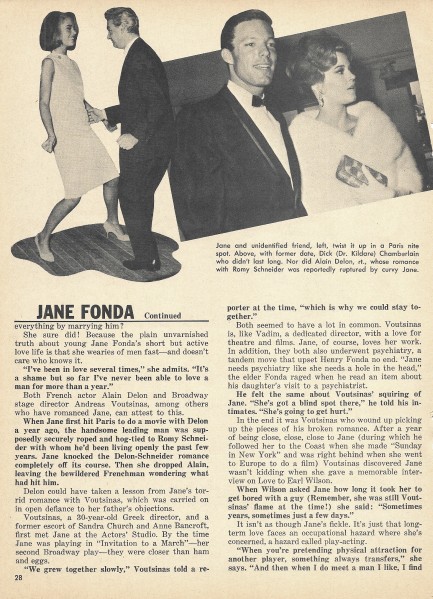 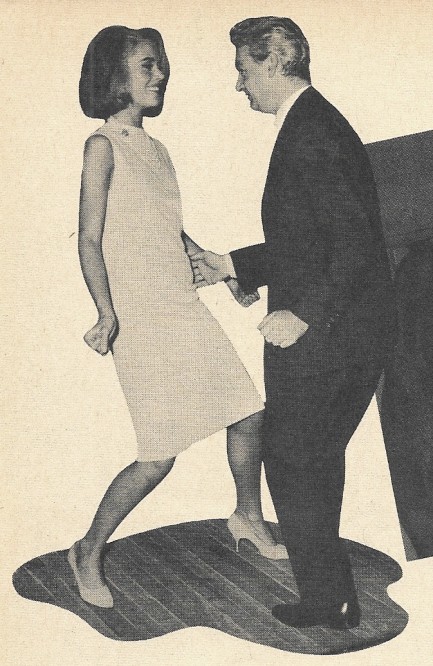 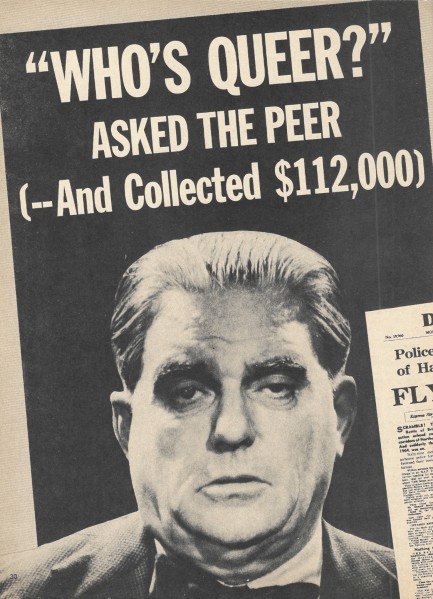 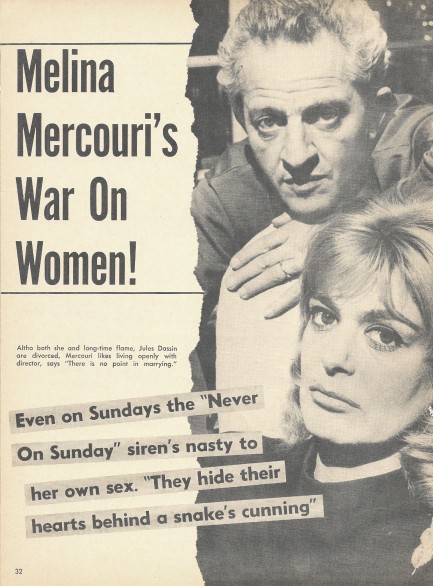 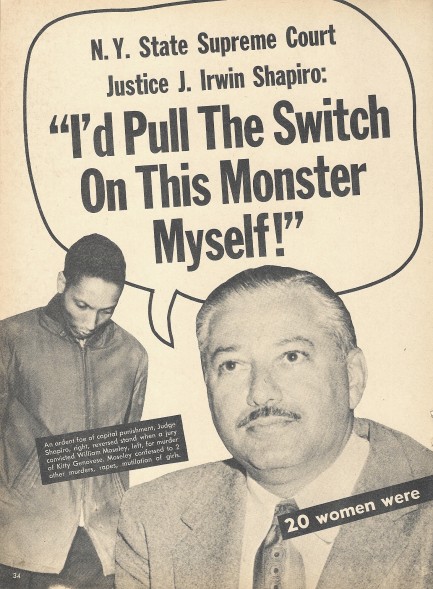 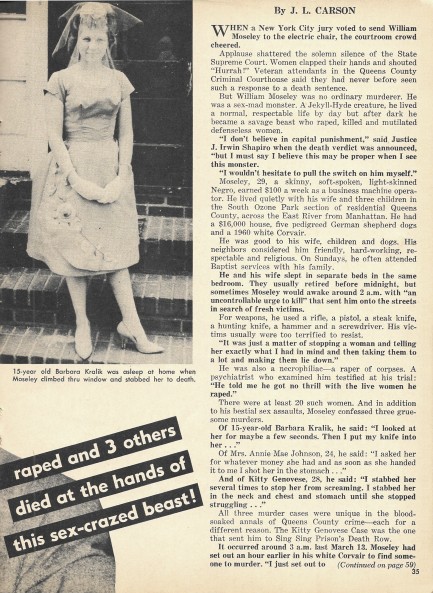 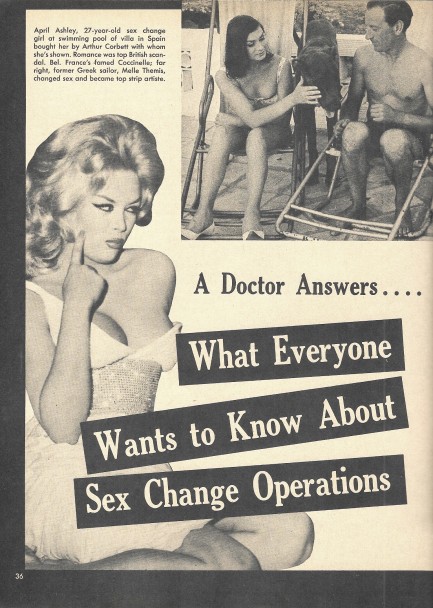 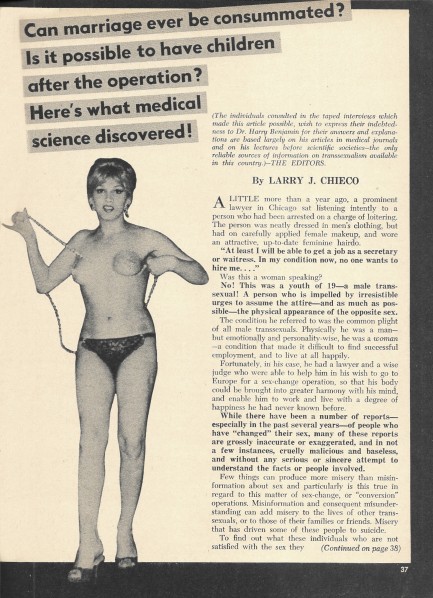 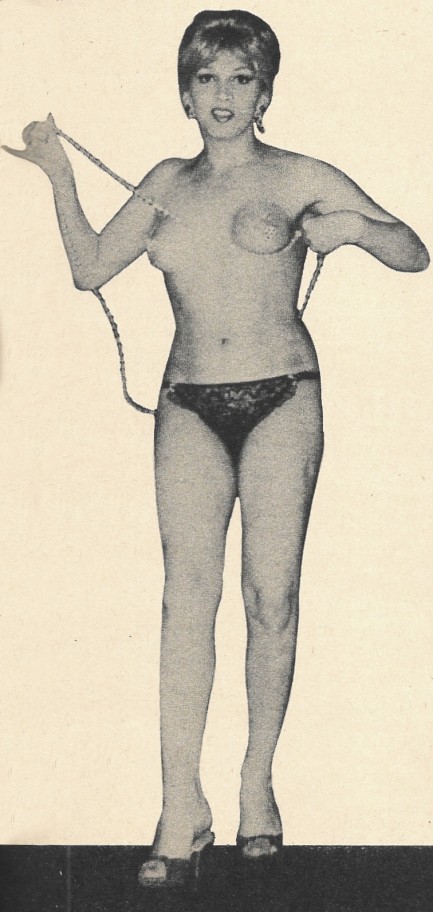 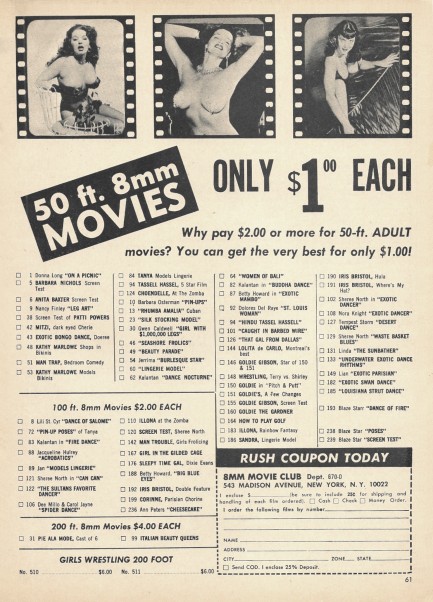
 Everybody, listen up! Grace is having a nap, so I guess the whole production has to grind to a halt until she's done. 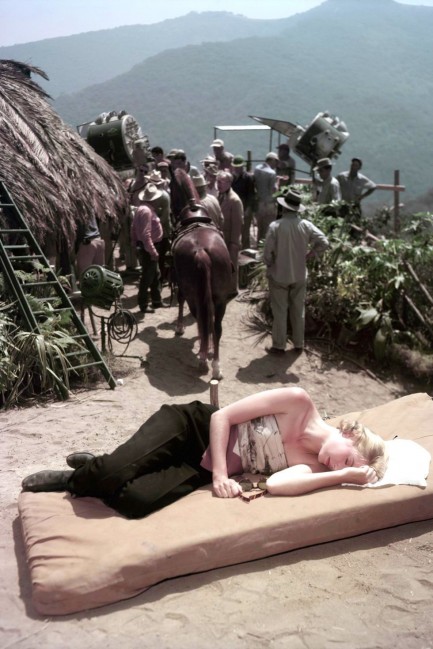
Online you see this photo captioned something like, “Grace Kelly has a nap in Africa on the set of the 1953 Metro-Goldwyn-Mayer movie Mogambo." It's clear, though, that the shot is staged. See all those footprints around Kelly's mattress? Grips, best boys, production assistants, and other species of cinematic wildlife have been constantly trekking through there lugging heavy gear. If she were really in need of a catnap we feel she'd be off to the side, somewhere under shelter from the brutal African sun, for example in a tent reserved for her, so we suspect she and the good folks at MGM chose this spot for a quick photo op. But it's a fun shot. In Africa or out of it, Kelly was hella hot.
 Mogambo features the cruelest beast in all of Africa—and its name is Clark Gable. 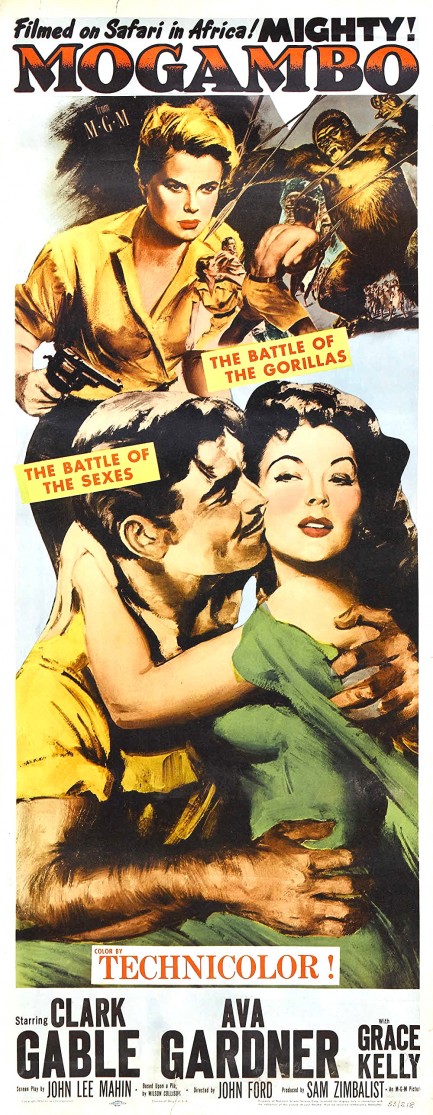
As famous as Mogambo is, we'd never seen it, had never read a review of it, and had no idea going in what it was about except that it was a safari movie and a remake of the 1932 adventure Red Dust, which we'd also never seen. There are few hit movies—especially with stars the stature of Clark Gable, Ava Gardner, and Grace Kelly—that we don't know at least a little something about. So we cleared the slate, cooked up some popcorn in our special Lindy's hand-cranked popper, and settled in for a screening.
Shot in Kenya, Uganda, French Equatorial Africa (now Central African Republic), and the Tanganyika region of what is now Democratic Republic of Congo, the movie is about a hard-edged safari guide and hunter played by Gable (also the star of Red Dust, by the way) who tries to score with both Gardner and Kelly, and soon has them at each other's throats. These old movies often work on the presumption that the male star is irresistible—period. As a result, screenwriters were sometimes lazy. They'd fail to write the male lead with any charm at all.
That holds true here, as Gable is gruff, rude, twenty years older than Gardner, and almost thirty years older than Kelly. We're fine about the age difference, unlike the “age appropriate” crowd that thinks women are capable of making any decision except ones about whom they love, but because Grant is a complete sourdough some charm would have made Gardner's and Kelly's attraction to him more understandable. Handsome though he may be, here he's nothing more than moustache, hair tonic, and bossiness. But okay, Gardner and Kelly are both in states of need, and Gable is more than happy to introduce them to his bush snake, so what you get is a love triangle folded inside a Technicolor safari adventure. Fine.
The production is spiced up with majestic scenery, nice costumes, realistic animal footage, an overwhelming feel of the exotic, the tantalizing implication of intimacy with two of the most beautiful women in cinema, and a deft, assured performance from Gardner. In fact, while Gable is top billed, Ava gets nearly all the good lines. “Listen, buster,” she scolds Clark, “you and your quick-change acts aren't gonna hang orange blossoms all over me just because you feel the cold weather coming on!” That's a scathing way to call someone old and desperate. But Gable has his moments too. We liked when he blustered, “You know how it is on safari. It's in all the books. The woman always falls for the white hunter and we guys make the most of it.” That's meta, so we hear.
Obviously, tribespeople figure prominently, and you can discern marginal improvement in their portrayal since the days of Weissmuller's Tarzan. They're still just ornamentation in their own lands, but at least none lay down their lives to save a white man who's spent most of his screen time cracking a whip at them. Whew. Overall, we thought Mogambo was decent. Not great, mind you—because Gable deserved to play a more nuanced character and did not have that chance—but it was decent. It premiered today in 1953.
 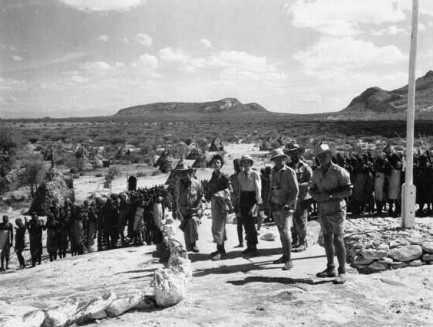 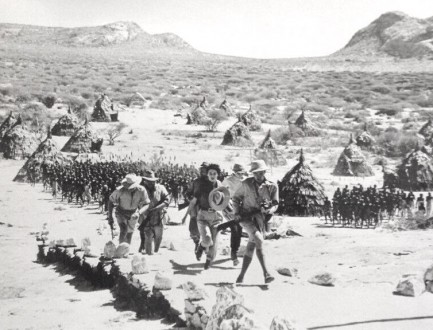 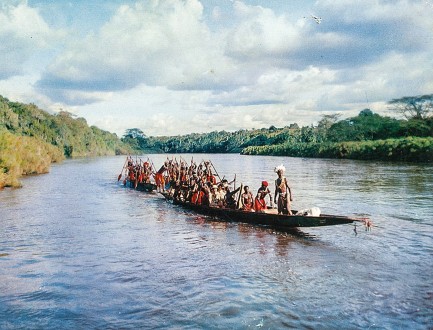 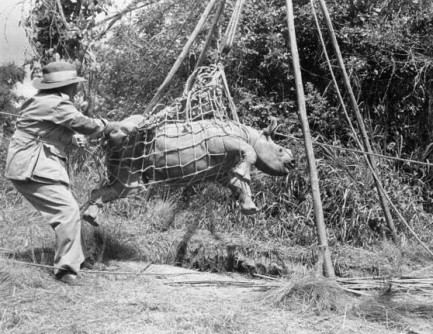 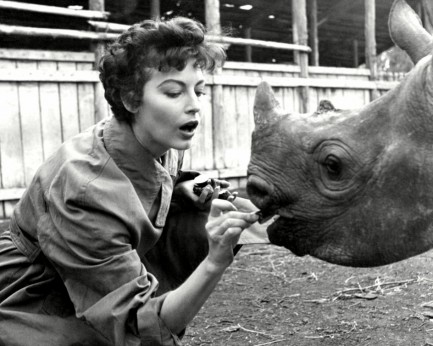 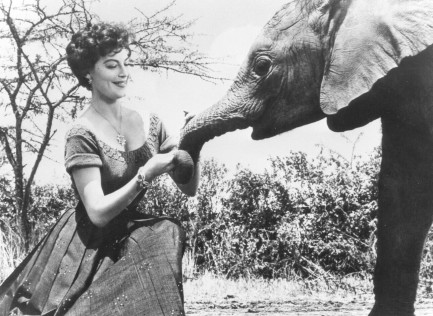 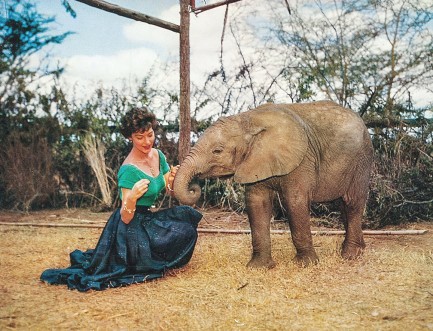 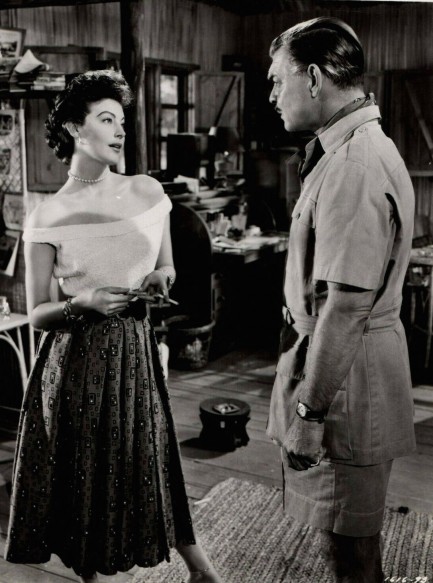 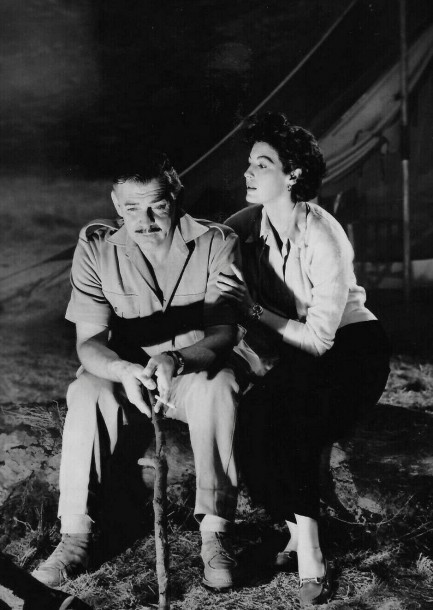 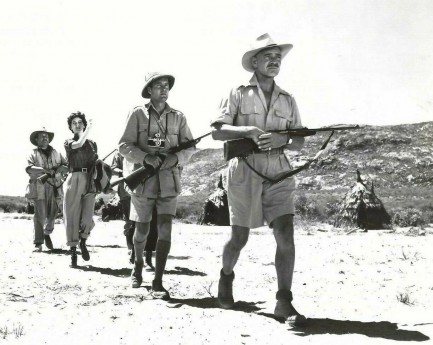 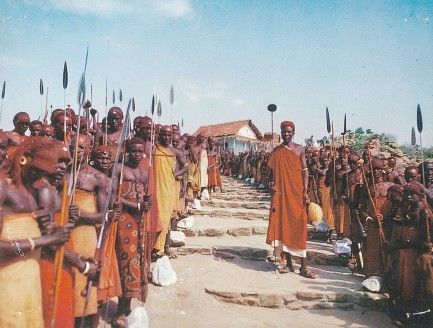 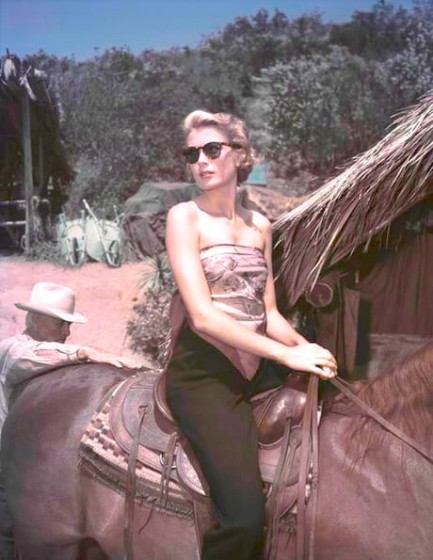 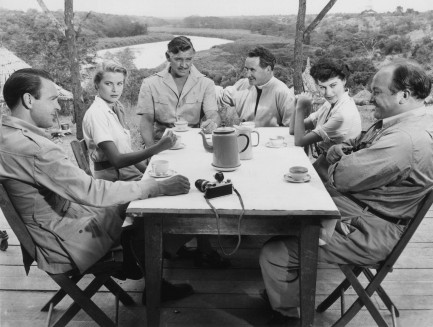 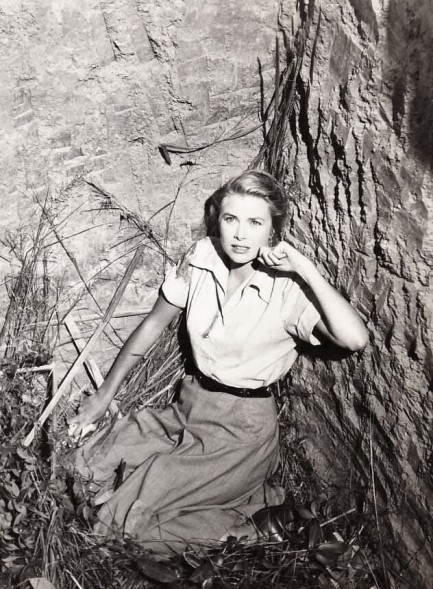 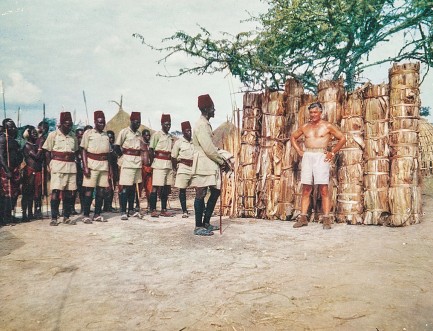 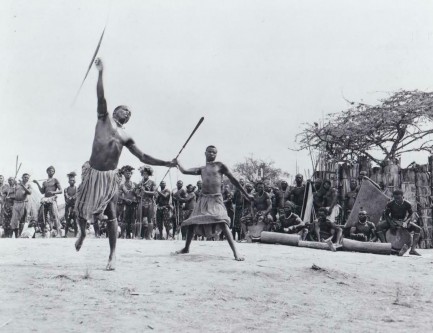  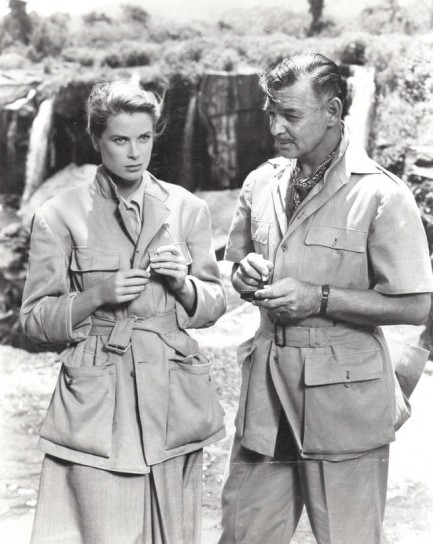  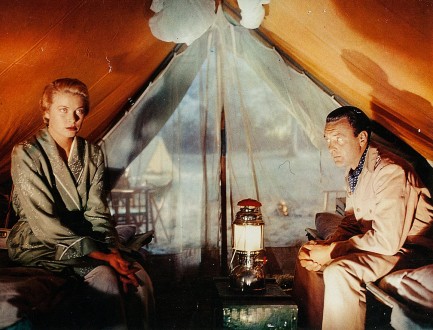 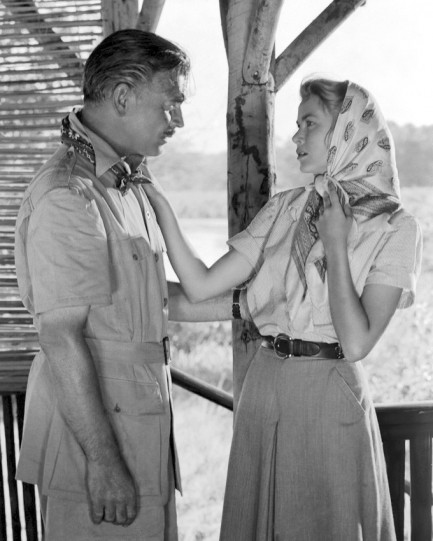 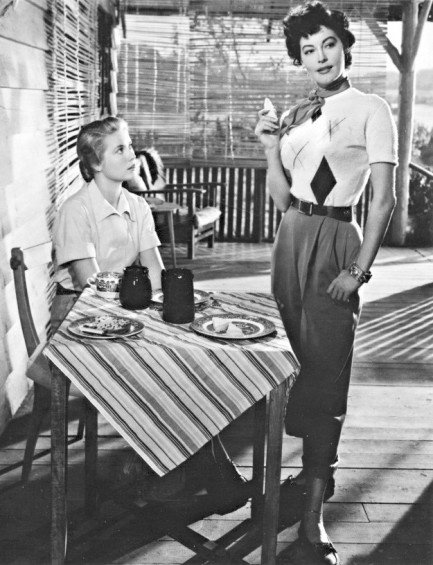 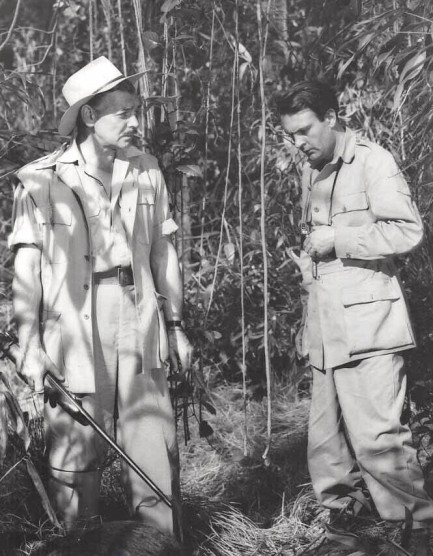 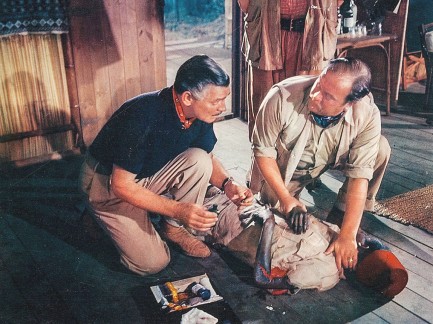 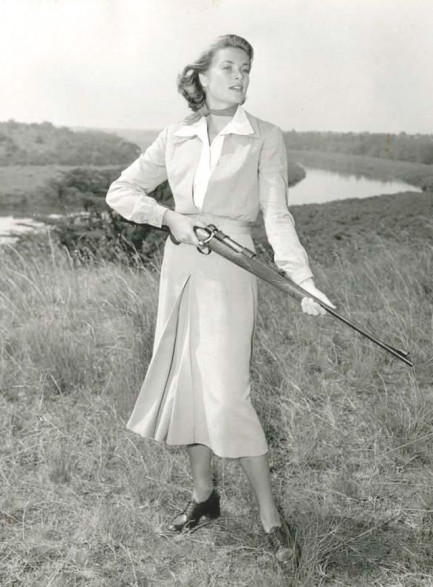 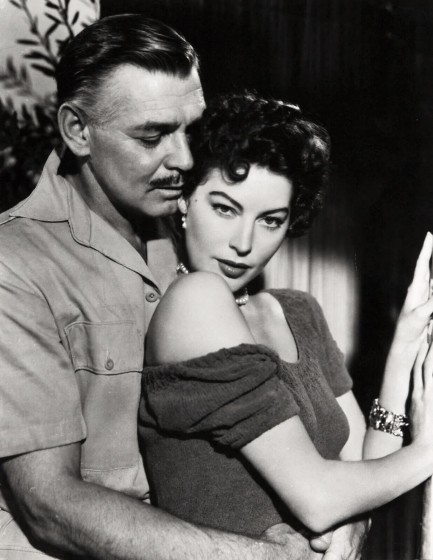  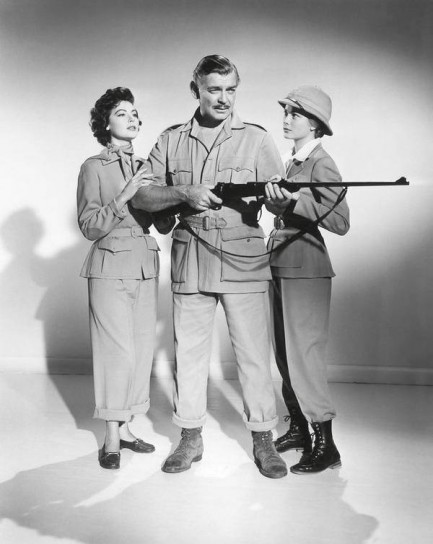 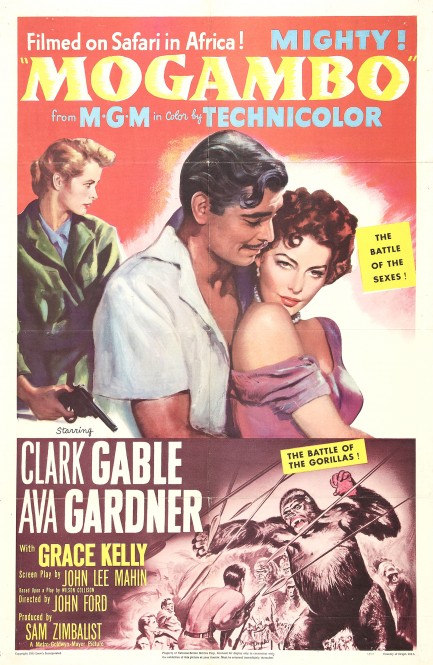
 How do you spell murder in Italian? H-i-t-c-h-c-o-c-k. 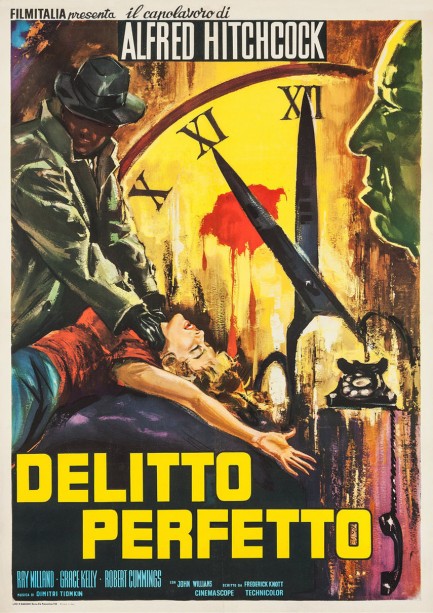
Above is a beautiful Italian poster for Delitto perfetto, better known as Alfred Hitchcock's Dial M for Murder, a movie we watch every five or seven years and always greatly enjoy. This semi-abstract effort isn't the only Italian poster for the film, but it's the best, in our view. We weren't able to find out who painted it, and considering it sold on a swanky auction site without that info, it seems as if nobody knows. Such good work uncredited, it's a shame. However, at this link you see another poster for the film, and that one is signed by Angelo Cesselon. Since both have a Hitchcock profile, and there's a stylistic similarity in other areas too, especially if you focus on the women's faces and the males' trench coats, we think it's possible Cesselon painted both pieces. The evidence wouldn't hold up in court, but it's good enough for us. Nice work, Angelo. Delitto perfetto premiered in Italy today in 1954.
 She didn't make it to the top of Hollywood just to accept being second banana in Monaco. 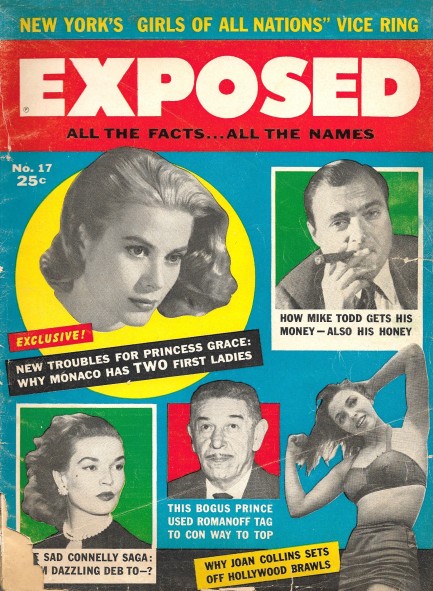
Yes, people were stupidly fawning over the rich long before 2021, as this issue of the tabloid Exposed published this month in 1957 proves. There are stories on one percenters ranging from Princess Grace of Monaco on down. Of course, there's an aspirational innocence to these old stories, because very few people, if any, begrudged the rich anything in this era. Those times have gone. Companies make hundreds of billions now and pay zero taxes. The rich have a thousand ways to hide their income, to the tune of 40 trillion dollars in cash hidden in tax havens around the world.
Something else different about the rich of yesterday—they didn't have dick-shaped rocket ships. Instead they had dick shaped yachts. And that's what the feud hinted at on the cover between Grace Kelly and Tina Onassis was about—in part at least. It was also about who threw the best parties, who had the richest and most influential friends, who had the best designer clothes, and who was the greatest beauty. Of course, Kelly was legendarily lovely, but because beauty marries money even when the money is as butt-ugly as Aristotle Onassis, Tina was no slouch.
Exposed tells us of one competitive episode the night Kelly was celebrating the birth of her daughter Caroline, which had happened a day earlier. Kelly lived in Grimaldi Palace, overlooking Monaco harbor, where Aristotle Onassis lived on an 1,800 ton former Canadian navy destroyer retrofitted as a luxury yacht. The night of Kelly's celebration Onassis left his boat totally dark in the harbor, then at one point flipped a switch that illuminated hundreds of light bulbs strung from prow to stern. Kelly's clan took it as an attempt to show her up. Sounds petty, right? Well, Exposed was a tabloid, and its readers absolutely devoured stories showing that they and the next door neighbor they hated weren't so very different from the one percent.
After that boat episode, according to Exposed, Kelly and Onassis barely saw each other in tiny Monaco, such was their determination to avoid each other. Again, the half-century old public obsession with these two seems quaint compared to people's interest in the Musks and Bransons of today. There are opinions and facts, and here is a fact—the U.S. is falling apart and miniscule taxes on the rich and corporations are the reason. During the year this issue of Exposed was published, a year many people now cast their misty eyes toward with longing and nostalgia, the tax rate for top income earners was 91%. No wonder things functioned so well, eh? High taxes kept the government flush and the rich weak.
But the highlight of the issue as far as we're concerned is Vikki Dougan, who we told you would return to Pulp Intl. soon, and who shows up at a party thrown by Hollywood astrologer Carroll Righter wearing one of her infamous buttcrack baring backless dresses. Exposed indeed. Since this is about as low as her gowns went, we zoomed in a bit so you can get a good look at the San Fernando Valley. Dougan by the way, is still around at age 92. Elsewhere in Exposed you get Joan Collins and her romances, restaurateur Mike Romanoff and his legal troubles, Paulette Goddard and her love of money, and vice in New York City. Thirty scans below.
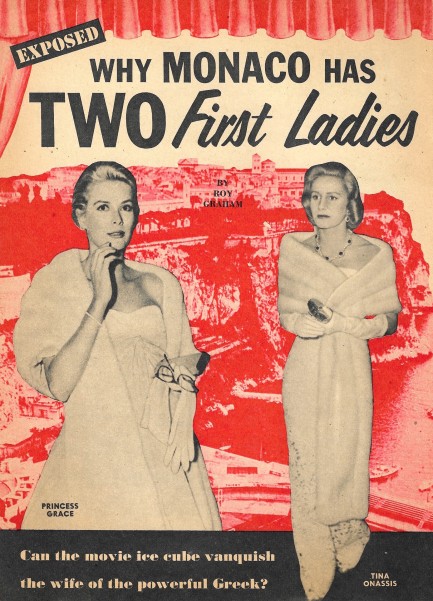 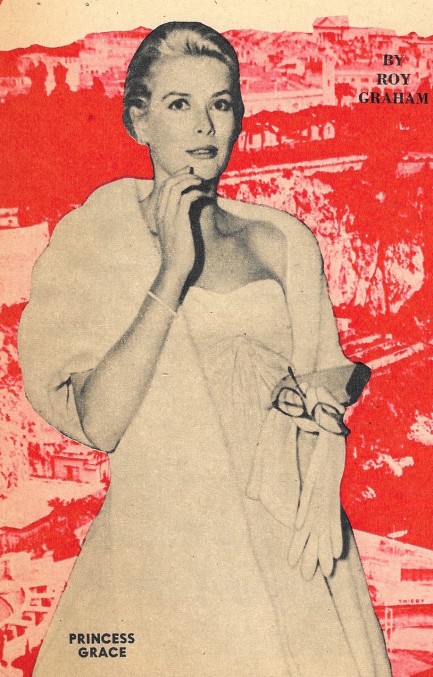 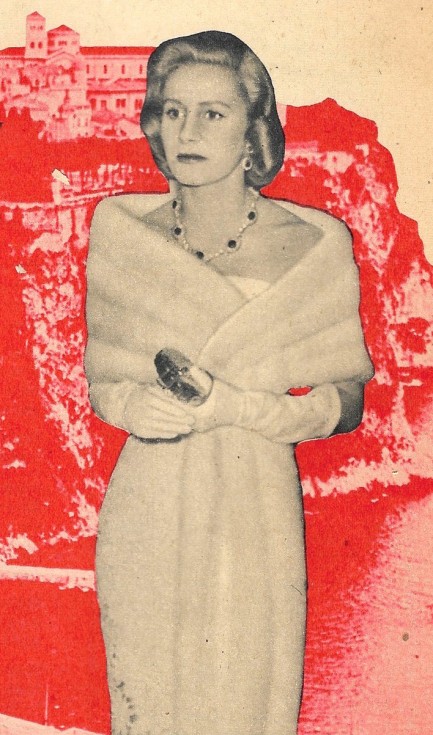 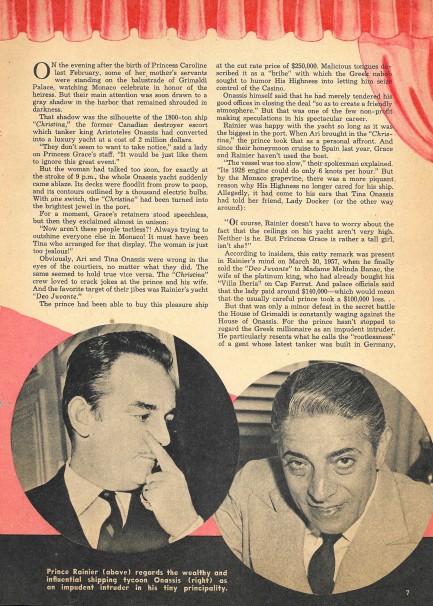 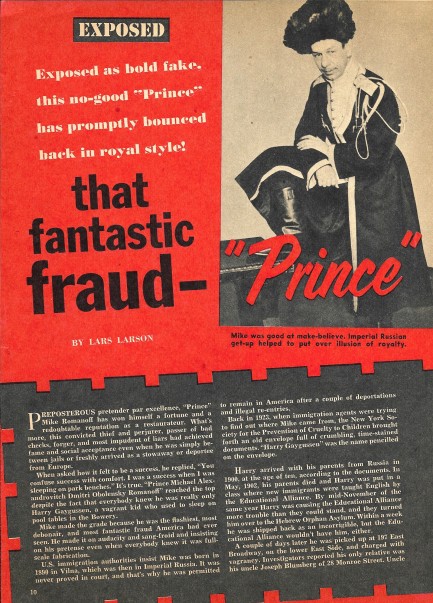 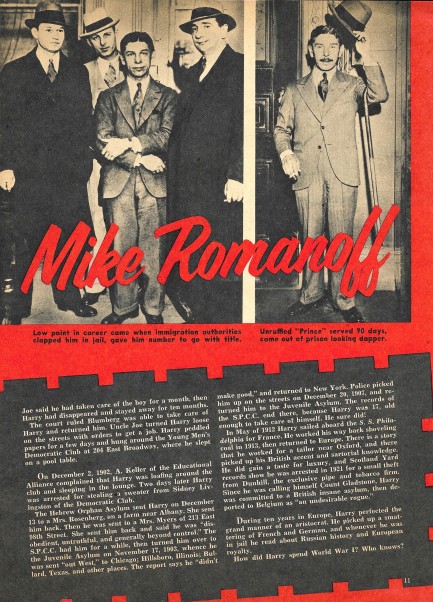 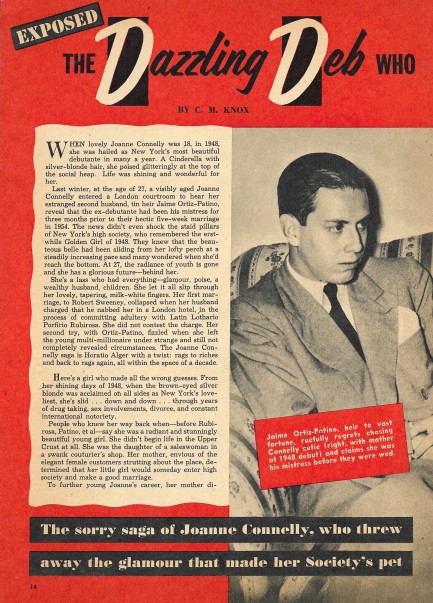 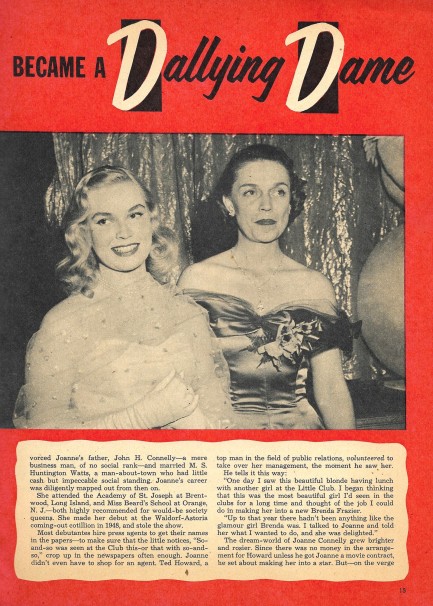 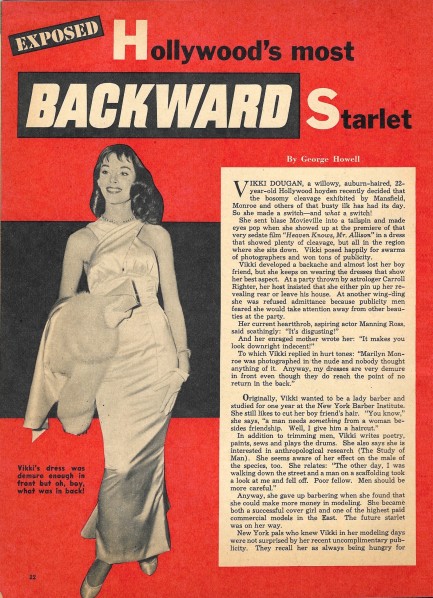 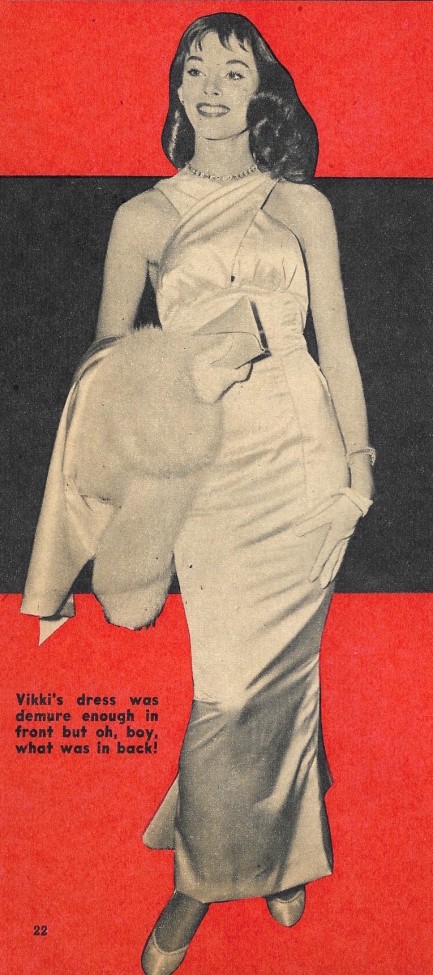 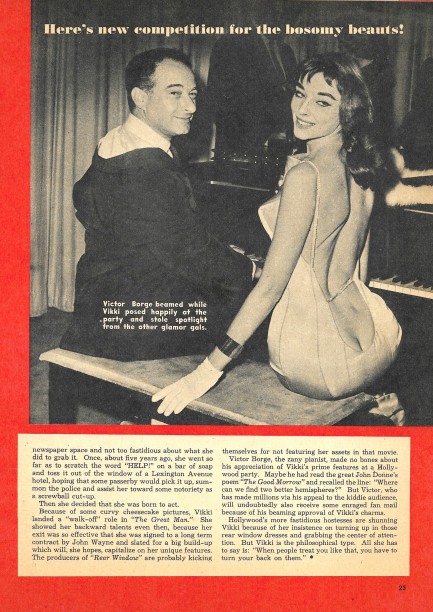 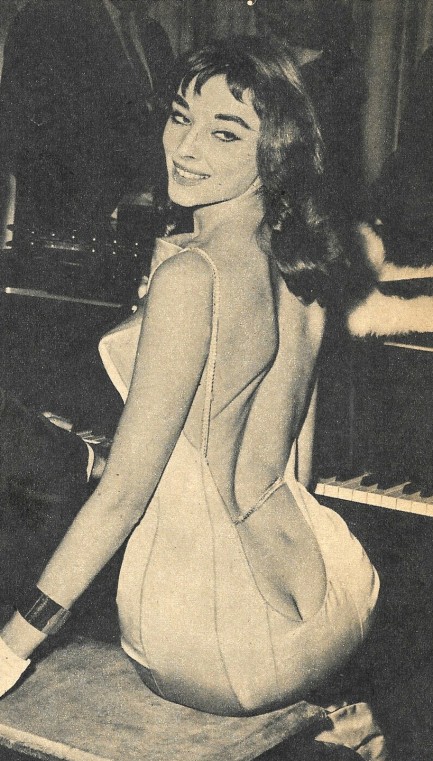  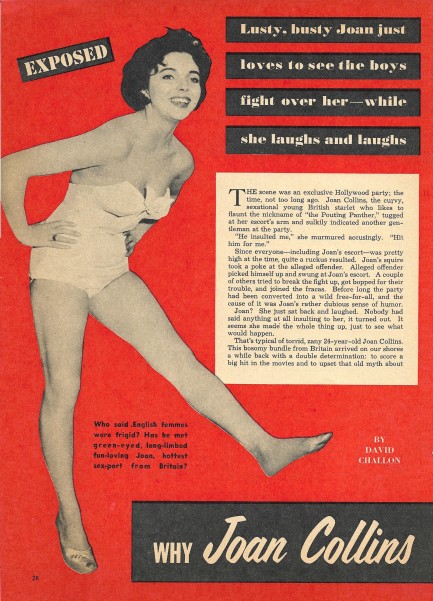 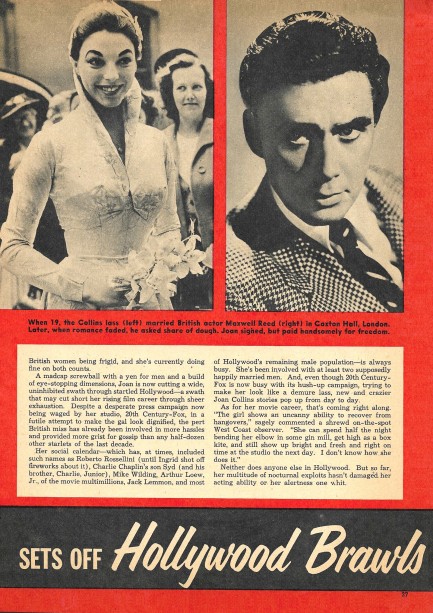 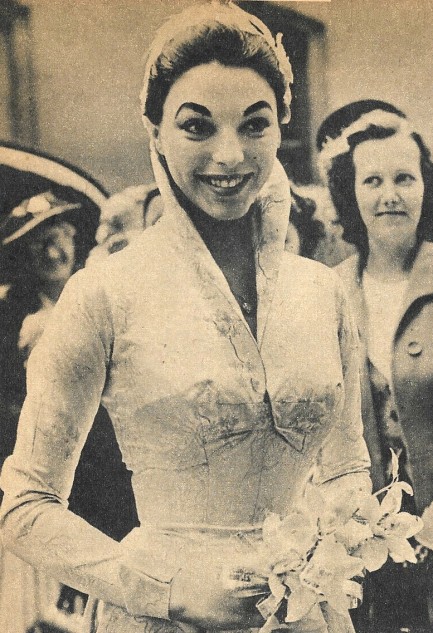 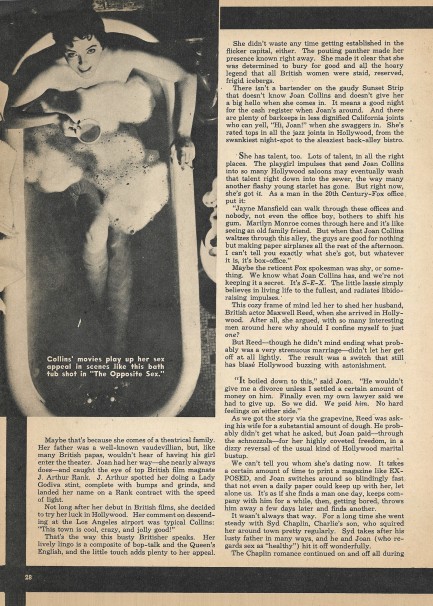 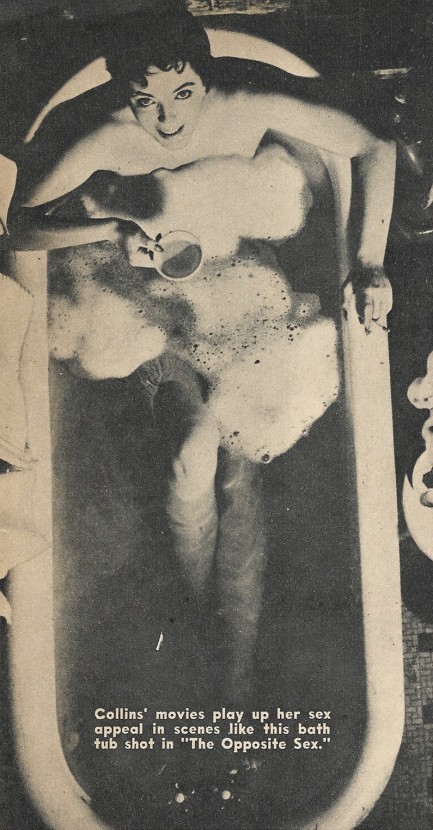 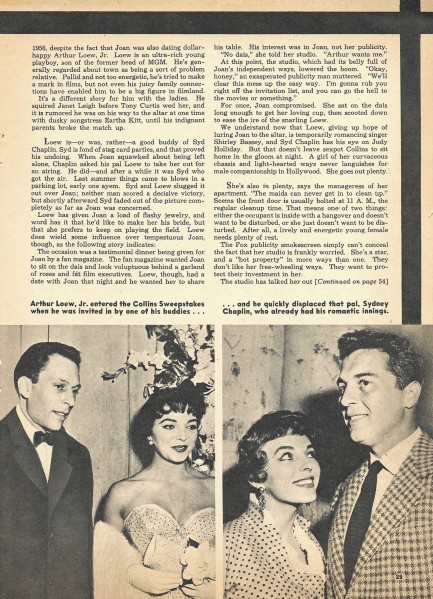 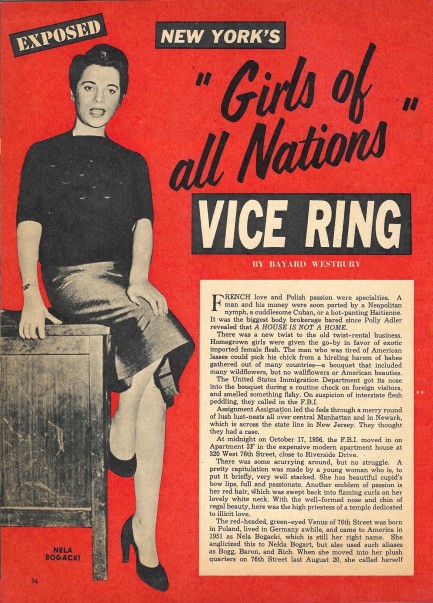 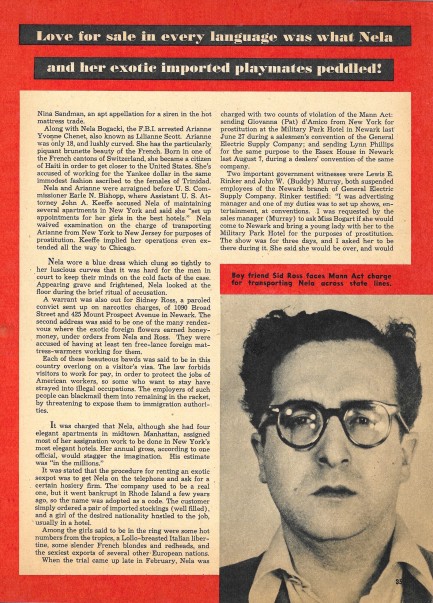 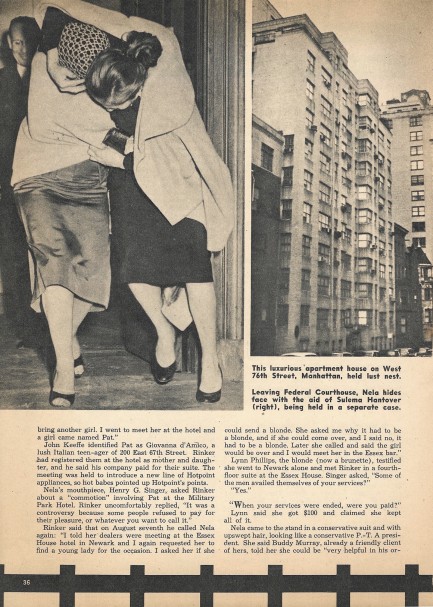 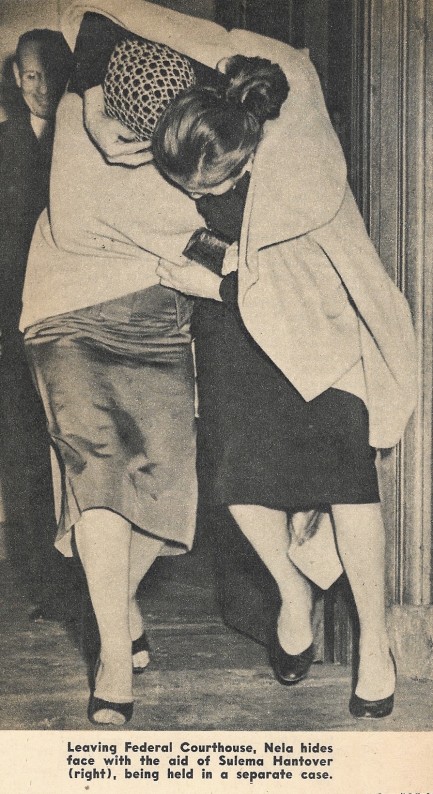 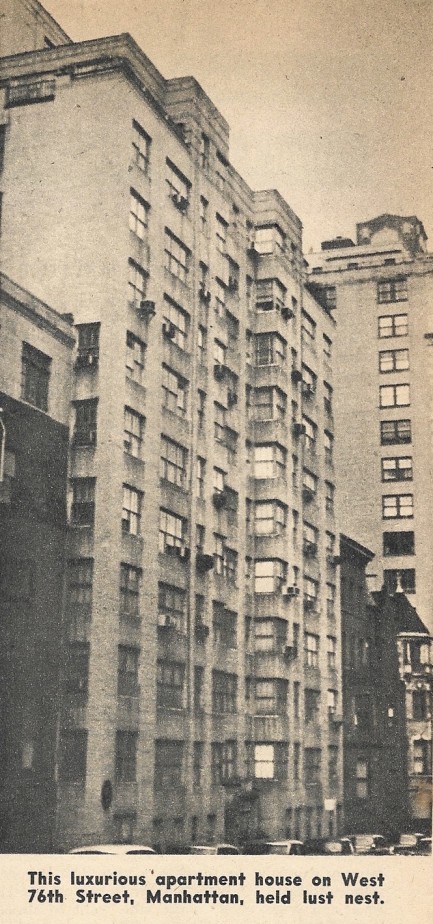 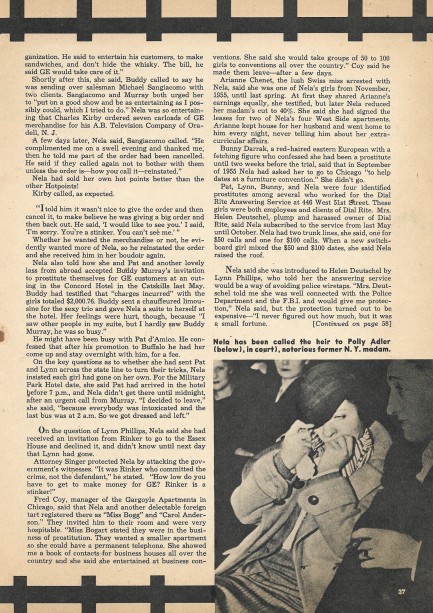 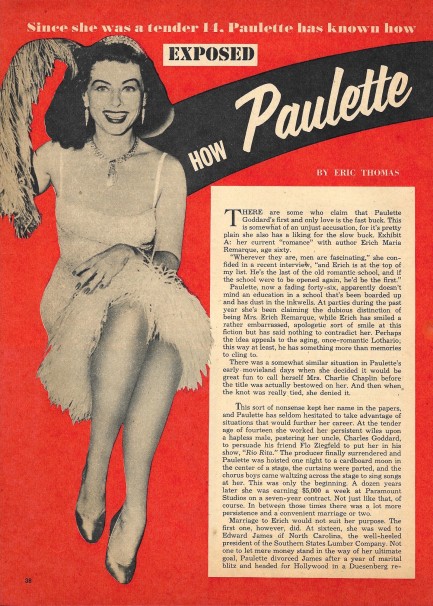 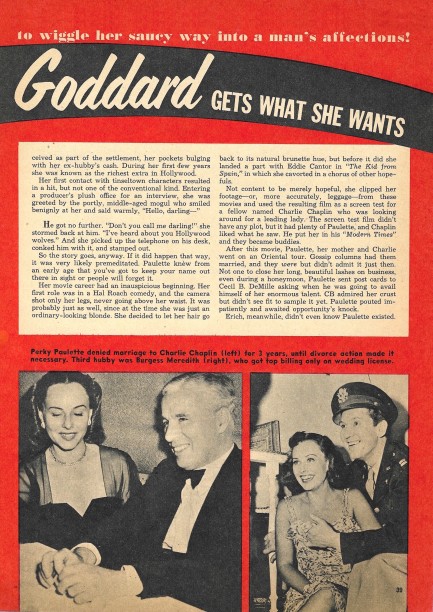  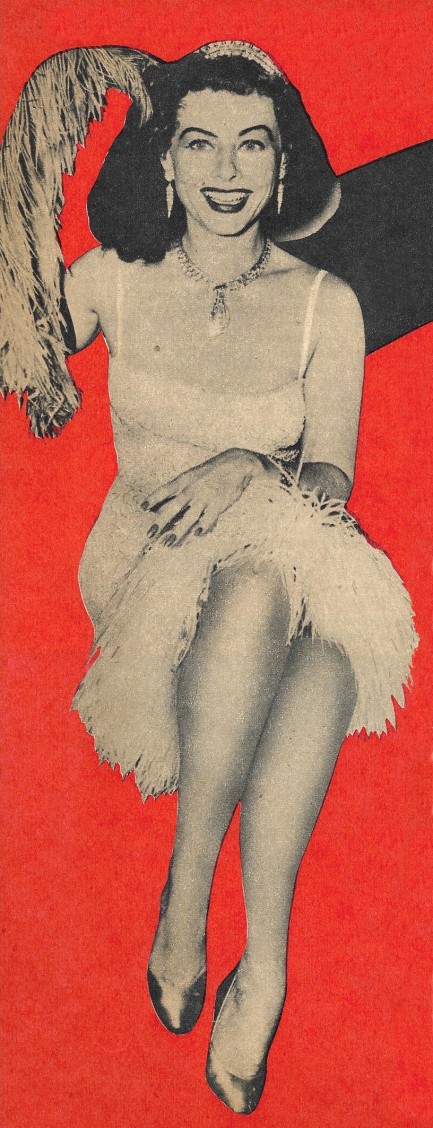
 To be a sidewalk pancake or not to be a sidewalk pancake. That is the question. 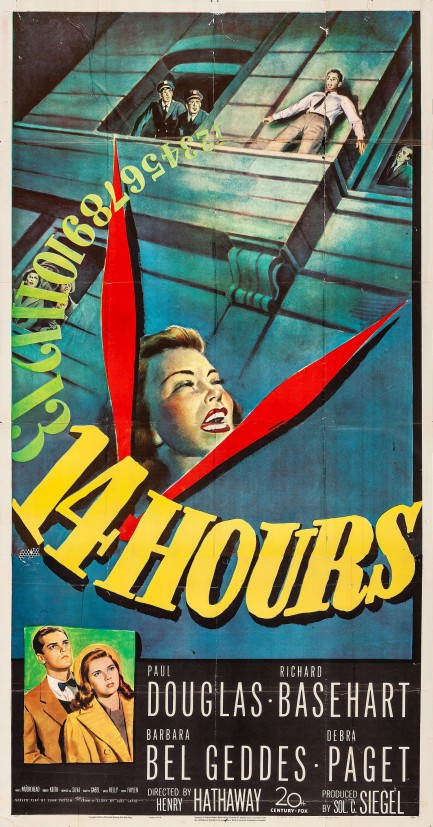
We have a friend who once said that everyone's problems can be boiled down to, “Mommy and daddy didn't love me enough.” We don't agree, but 14 Hours, aka Fourteen Hours, takes that idea and runs with it as far and fast as it can, as Richard Basehart climbs onto a New York City hotel ledge and engages in the eternal existential wrestling match: To be or not to be? Most of the movie takes place on that ledge, as a beat cop played by Paul Douglas tries to talk Basehart out of splattering himself all over 55th Street.
The performances in this film were acclaimed at the time, and it also has an interesting collection of young, soon-to-be stars, including Debra Paget, pretty boy Jeffery Hunter, Barbara Bel Geddes, and the legendary Grace Kelly, who's twenty-two yet plays a mother of two about to be divorced. Yes, there are twenty-two-year-old mothers of two facing divorce, but it feels like a case of shoehorning her into the movie when her role was clearly written for an older actress. But hey, shoehorn away—she's Grace Kelly. She can play King Kong as far as we're concerned.
14 Hours is, on the whole, an involving and speedy flick. It is not a film noir, and we wish IMDB and Wikipedia didn't let their users label every vintage black and white drama a noir. This one is not even close to noir. It has almost none of that genre's standard iconography, and also lacks its required thematic underpinning. The American Film Institute officially calls it a suspense drama. Whatever its category, 14 Hours' ninety-two minutes are entertaining and technically proficient. To watch or not to watch? We say yes. It premiered in the U.S. today in 1951.
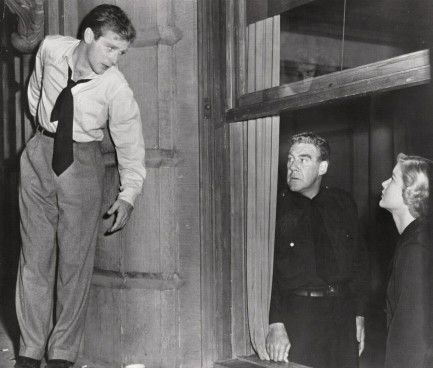 If you'd had sex with me I wouldn't be out here with the pigeons right now. If you'd had sex with me I wouldn't be out here with the pigeons right now.
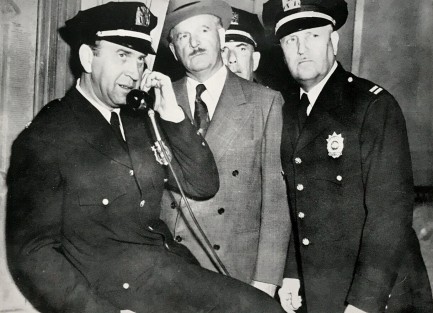 Headquarters? Do not—I repeat do not—eat all the donuts. We'll get this nutjob off the ledge and be back there as quick as we can. Headquarters? Do not—I repeat do not—eat all the donuts. We'll get this nutjob off the ledge and be back there as quick as we can.
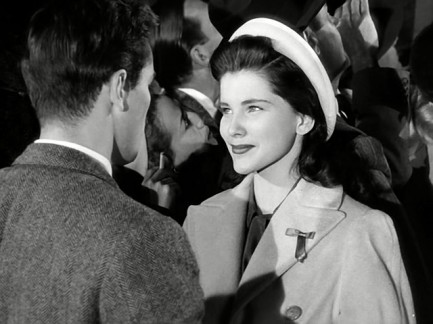 I certainly don't want you to get desperate enough to climb onto a ledge. Let's go to your place and I'll show you what life is all about. I certainly don't want you to get desperate enough to climb onto a ledge. Let's go to your place and I'll show you what life is all about.
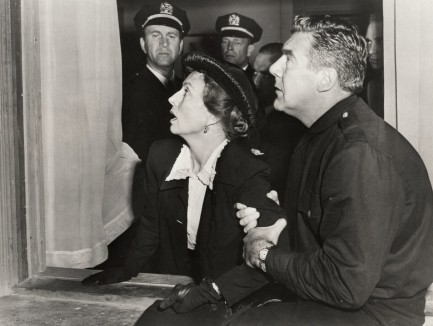 Don't jump, son! Without you there'll be nobody around to listen to me complain about what a loser your father is! Don't jump, son! Without you there'll be nobody around to listen to me complain about what a loser your father is!
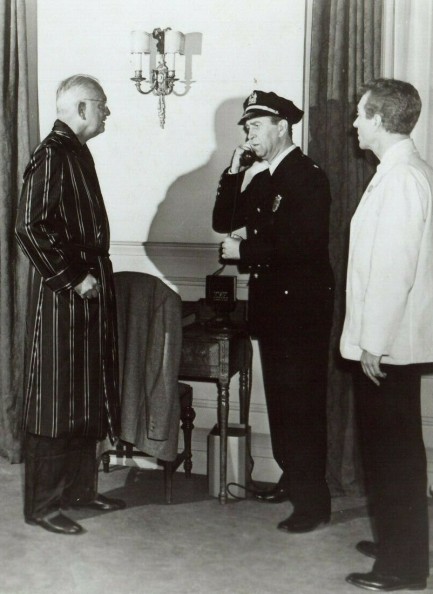 Hello, headquarters? Status check on those donuts. Hello, headquarters? Status check on those donuts.
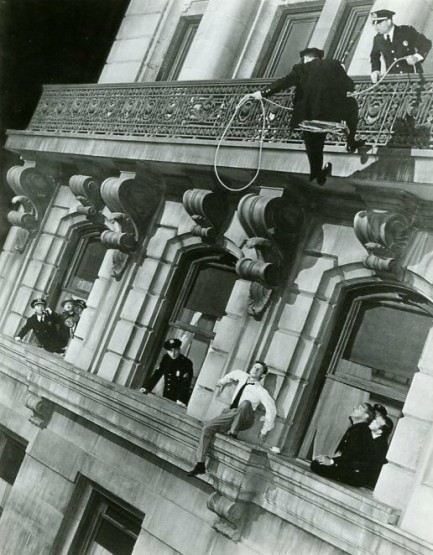 Just cooperate, mister! There are a lot of hungry cops up here! Just cooperate, mister! There are a lot of hungry cops up here!
 No tricks here—just two superstars at their very best. 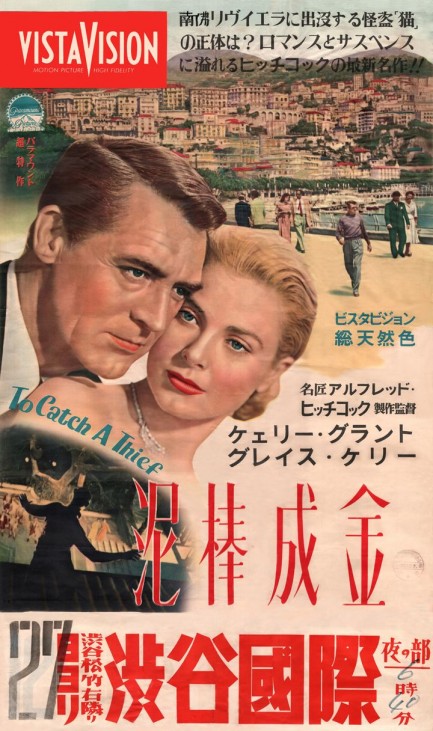
Above is a beautiful Japanese poster for 泥棒成金, or Dorobô narikin, much better known as To Catch a Thief. We bet just seeing Cary Grant and Grace Kelly's faces told you that at a glance. Don't believe the hype in full—Grant and Kelly are two of the era's most mesmerizing stars and are in amazing form, but this film is decent-not-great. It had its Japanese premier today in 1955.
 Hitchcock says no festival for you this year! 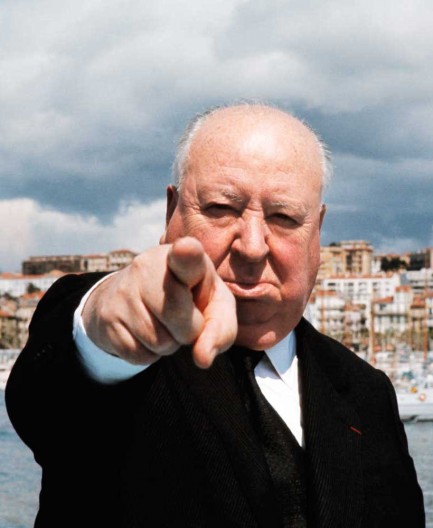
The 73rd edition of the Festival de Cannes, aka the Cannes Film Festival, would have kicked off today in the south of France, but was cancelled a while back. It's just one of a wave of event cancellations that will cascade through the year. Festivals as diverse as Burning Man and San Fermin, aka the Running of the Bulls, have also been shelved. But getting back to Cannes, we thought this would be a good moment to commemorate past fests with some historical photos. Above you see Alfred Hitchcock on a boat with the town in the background, in 1972, and below are about fifty pix from the 1940s through 1970s, documenting various iconic moments, and a few quieter ones. Maybe the Cannes Film Festival will back next year, maybe not. At this point, predicting anything is an exercise in futility. But at least we'll always have the memories. 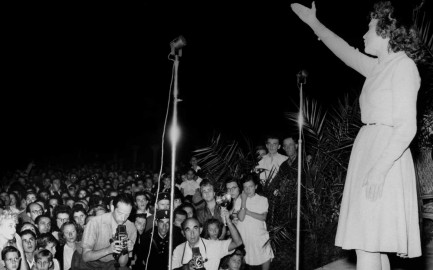 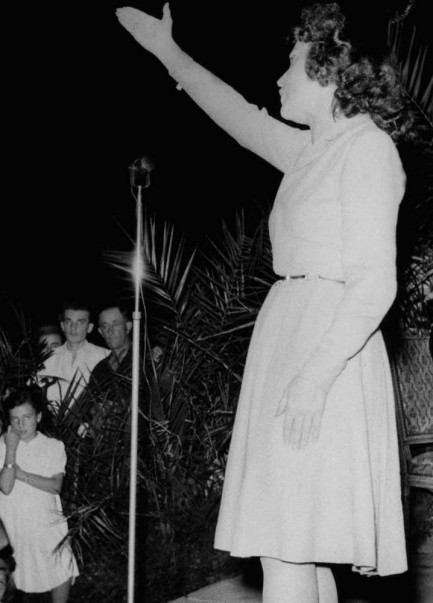 Edith Piaf sings on the terrace of the Carlton Hotel on the iconic Boulevard de la Croisette at the first Festival de Cannes to be held under that name, in 1946. Back then the event took place in September and October, but would shift to May a bit later. Edith Piaf sings on the terrace of the Carlton Hotel on the iconic Boulevard de la Croisette at the first Festival de Cannes to be held under that name, in 1946. Back then the event took place in September and October, but would shift to May a bit later.
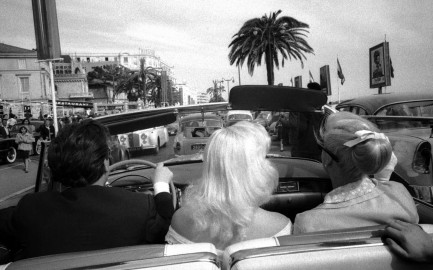 Diana Dors and Ginger Rogers arrive at the fest the only way anyone should—breezing along the beachfront in a convertible, in 1956, with an unknown driver. Diana Dors and Ginger Rogers arrive at the fest the only way anyone should—breezing along the beachfront in a convertible, in 1956, with an unknown driver.
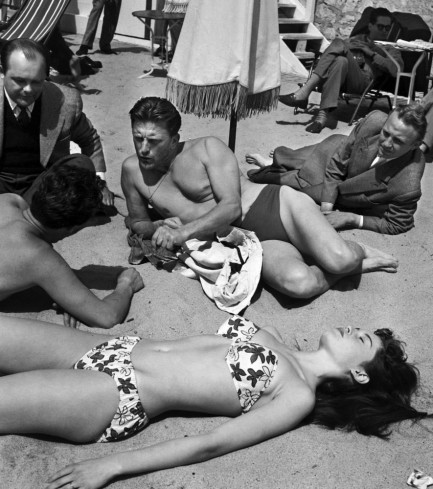 Kirk Douglas holds court on the beach in 1953, and Brigitte Bardot soaks up rays in the foreground. Kirk Douglas holds court on the beach in 1953, and Brigitte Bardot soaks up rays in the foreground.
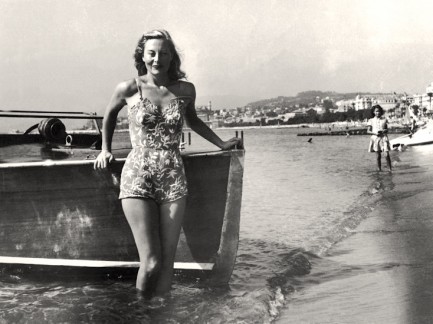 Michele Morgan poses at the first Festival in 1946. Photo ops of this sort were essential sources of publicity for stars, and would soon become opportunities for non-stars seeking to be discovered. Michele Morgan poses at the first Festival in 1946. Photo ops of this sort were essential sources of publicity for stars, and would soon become opportunities for non-stars seeking to be discovered.
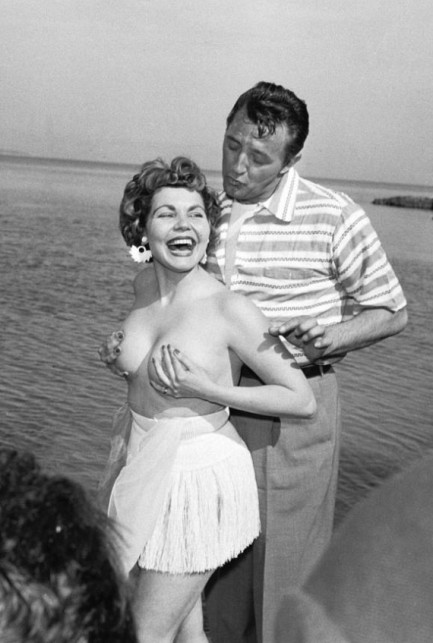 Case in point. Robert Mitchum poses with actress Simone Sylva in 1954. Sylva was allegedly not supposed to be there, but shucked her top and photo-bombed Douglas in an attempt to raise her profile. It didn't work. She made only a couple of credited movie appearances after her topless stunt. Case in point. Robert Mitchum poses with actress Simone Sylva in 1954. Sylva was allegedly not supposed to be there, but shucked her top and photo-bombed Douglas in an attempt to raise her profile. It didn't work. She made only a couple of credited movie appearances after her topless stunt.
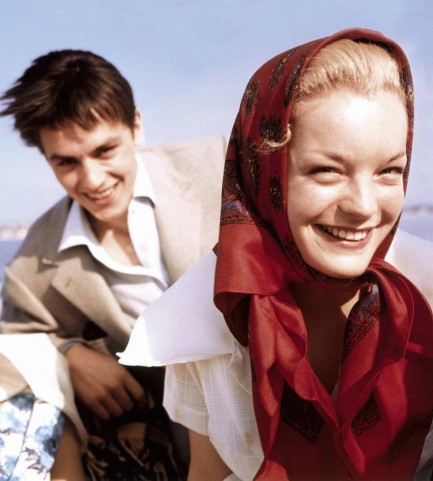 Romy Schneider and Alain Delon at the 1959 fest. Romy Schneider and Alain Delon at the 1959 fest.
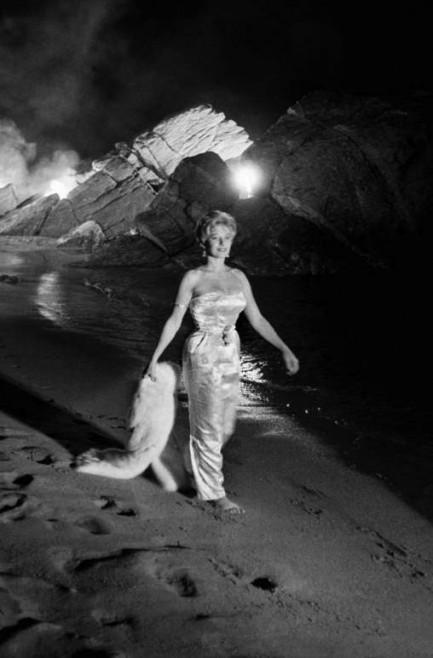 An unidentified model or actress poses in the style of Anita Ekberg from La dolce vita in 1960. This looks like it was shot at Plage du Midi, which is a beach located a little ways west of the Cannes town center. An unidentified model or actress poses in the style of Anita Ekberg from La dolce vita in 1960. This looks like it was shot at Plage du Midi, which is a beach located a little ways west of the Cannes town center.  A unidentified partygoer is tossed into a swimming pool after La Dolce Vita won the the 1960 Palme d’Or. The Festival is almost as well known for legendary parties as for legendary film premieres. A unidentified partygoer is tossed into a swimming pool after La Dolce Vita won the the 1960 Palme d’Or. The Festival is almost as well known for legendary parties as for legendary film premieres.
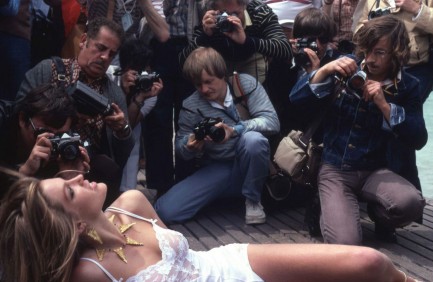 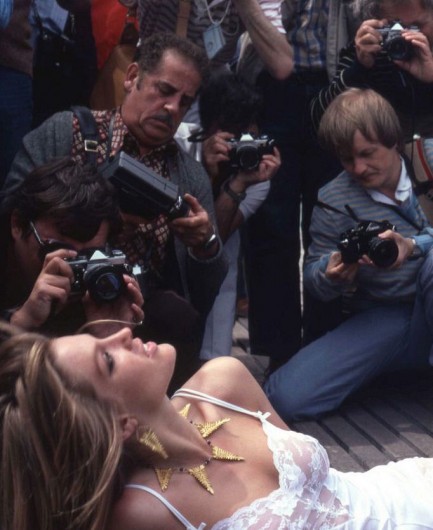 Another unidentified model or actress poses on the boardwalk in 1979. Generally, you don't have to be known to draw a crowd of photographers—you just have to be nearly bare. She's wearing lingerie, so that explains the interest, though this is modest garb for a Cannes publicity stunt. It's never a surprise to see a headline-seeking film hopeful strip all the way down to a string ficelle féminin, or thong, which is the limit of what is legal in Cannes Another unidentified model or actress poses on the boardwalk in 1979. Generally, you don't have to be known to draw a crowd of photographers—you just have to be nearly bare. She's wearing lingerie, so that explains the interest, though this is modest garb for a Cannes publicity stunt. It's never a surprise to see a headline-seeking film hopeful strip all the way down to a string ficelle féminin, or thong, which is the limit of what is legal in Cannes
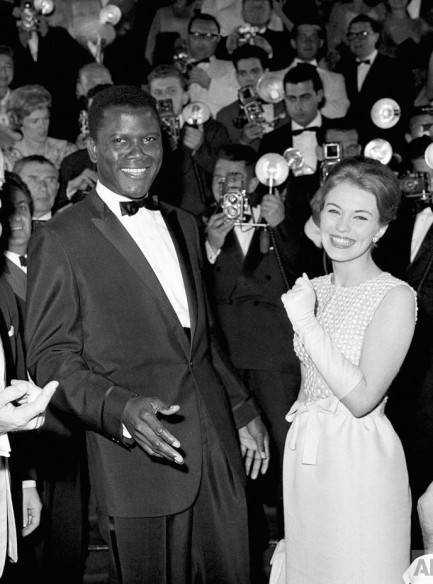 Sidney Poitier and Jean Seberg have a laugh in 1961. This was the year Poitier's flick Paris Blues was released, so it's possible he had jetted down from the capital for the Festival. Sidney Poitier and Jean Seberg have a laugh in 1961. This was the year Poitier's flick Paris Blues was released, so it's possible he had jetted down from the capital for the Festival.
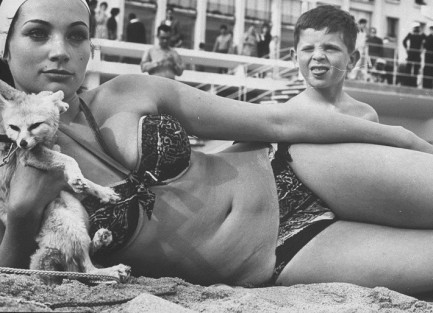 Philomène Toulouse relaxes on the sand in 1962 while a boy practices the classic French look of disgust he'll be using the rest of his life. Philomène Toulouse relaxes on the sand in 1962 while a boy practices the classic French look of disgust he'll be using the rest of his life.  Actor Bernard Blier, 1975. Actor Bernard Blier, 1975. 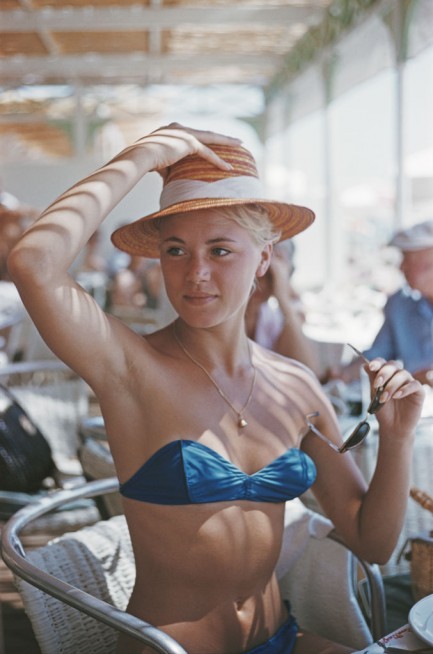 An unidentified bikini wearer boldly enjoys a lunch in a café on the Croisette, 1958. An unidentified bikini wearer boldly enjoys a lunch in a café on the Croisette, 1958. 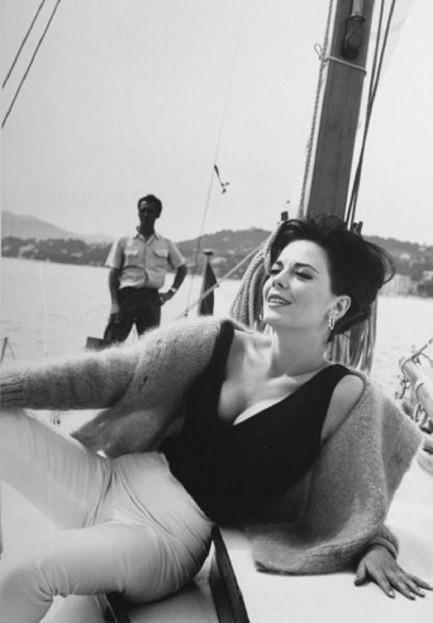 Natalie Wood aboard a sailboat in 1962. Natalie Wood aboard a sailboat in 1962.
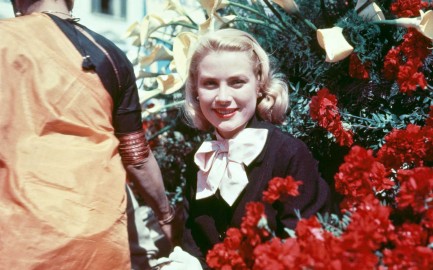 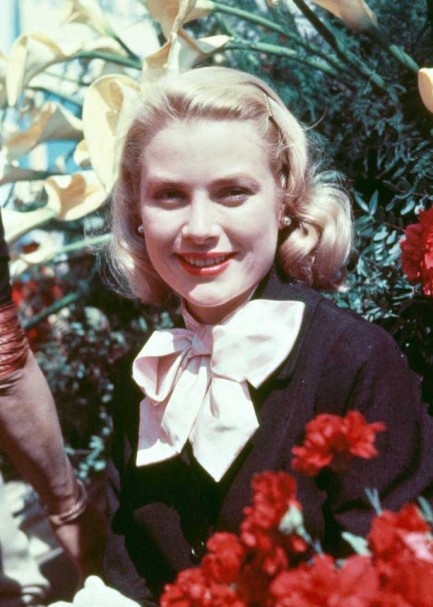 Grace Kelly, 1955. Grace Kelly, 1955.
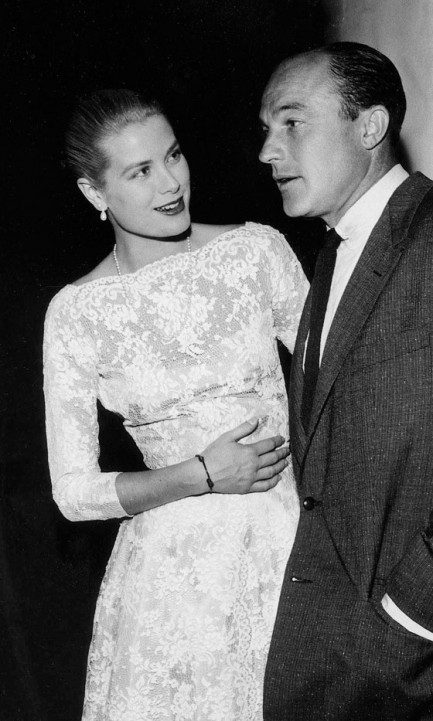 Kelly times two—Grace Kelly and Gene Kelly, hanging out, also in 1955. Kelly times two—Grace Kelly and Gene Kelly, hanging out, also in 1955.
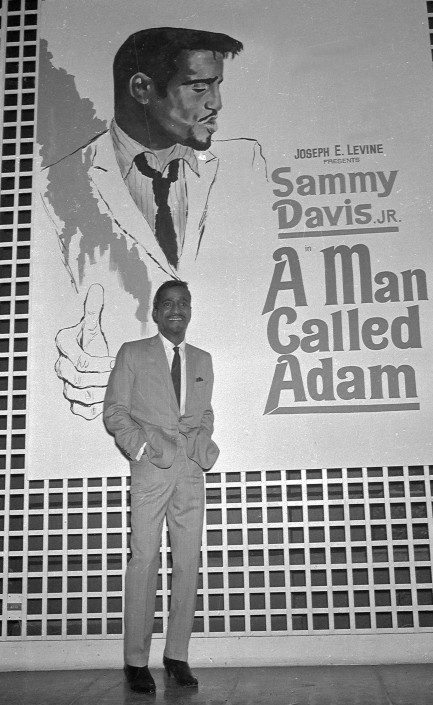 Sammy Davis, Jr. poses in front of a billboard promoting his film A Man Called Adam, 1966. Sammy Davis, Jr. poses in front of a billboard promoting his film A Man Called Adam, 1966. 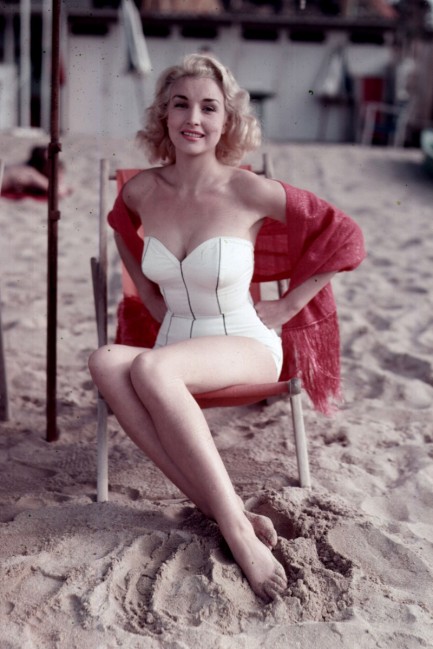 Joan Scott gets sand between her toes in 1955. Scott is obscure. She isn't even the most famous Joan Scott anymore. The IMDB entry for the only Joan Scott near the appropriate age is for an actress born in 1920 who didn't begin acting until 1967. The Joan Scott above doesn't look thirty-five, though, and we doubt she would have been the subject of this somewhat well-known photo without parlaying it into a film appearance before twelve years had passed. So we don't think this is the Joan Scott referenced on IMDB. Joan Scott gets sand between her toes in 1955. Scott is obscure. She isn't even the most famous Joan Scott anymore. The IMDB entry for the only Joan Scott near the appropriate age is for an actress born in 1920 who didn't begin acting until 1967. The Joan Scott above doesn't look thirty-five, though, and we doubt she would have been the subject of this somewhat well-known photo without parlaying it into a film appearance before twelve years had passed. So we don't think this is the Joan Scott referenced on IMDB. 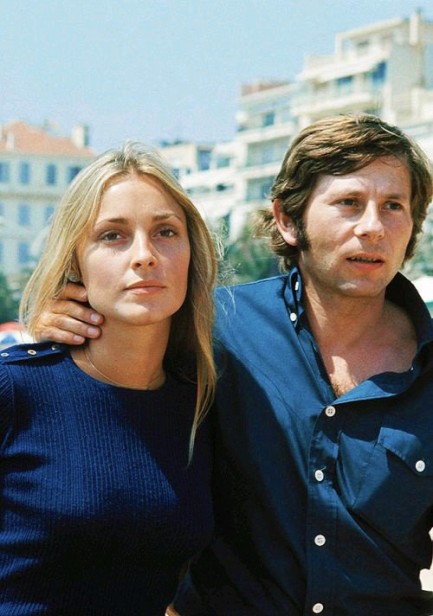 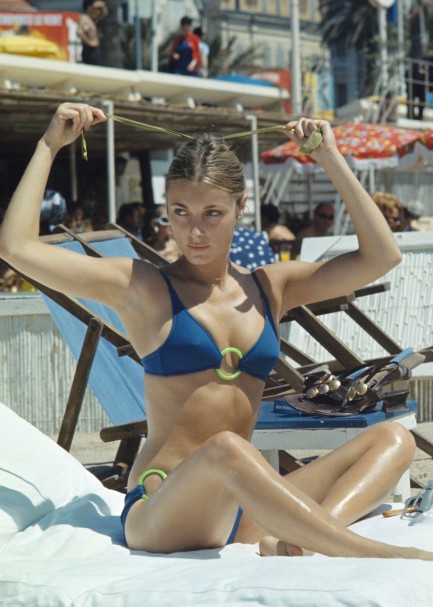 Sharon Tate, with Roman Polanski, and solo, 1968. Sharon Tate, with Roman Polanski, and solo, 1968.
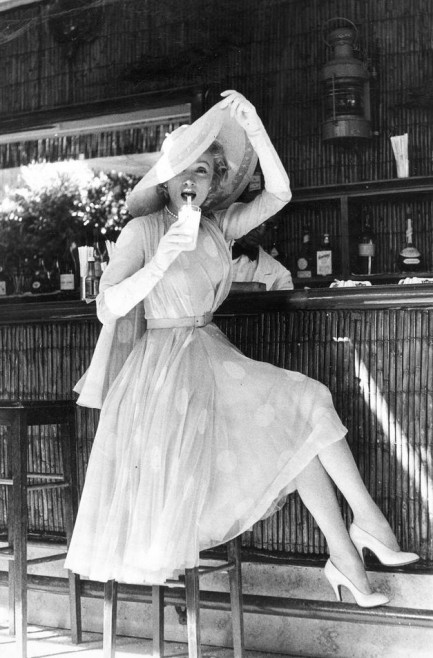 Marlene Dietrich brings glamour to a tiki themed bar in 1958. Marlene Dietrich brings glamour to a tiki themed bar in 1958.
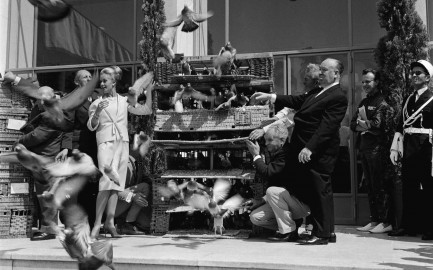 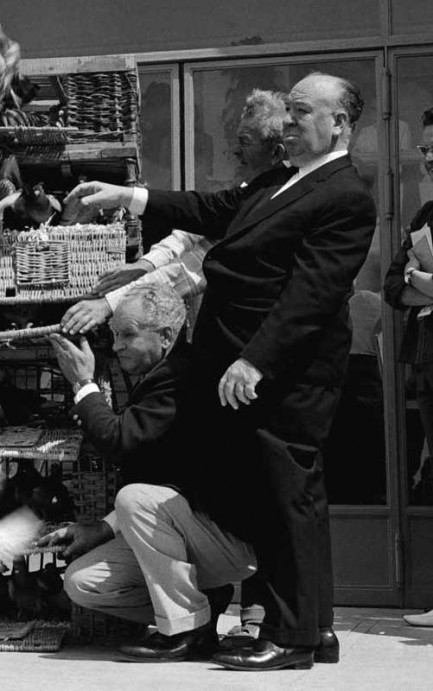 Tippi Hedren and Alfred Hitchcock release caged birds as a promo stunt for The Birds in 1963. Tippi Hedren and Alfred Hitchcock release caged birds as a promo stunt for The Birds in 1963.
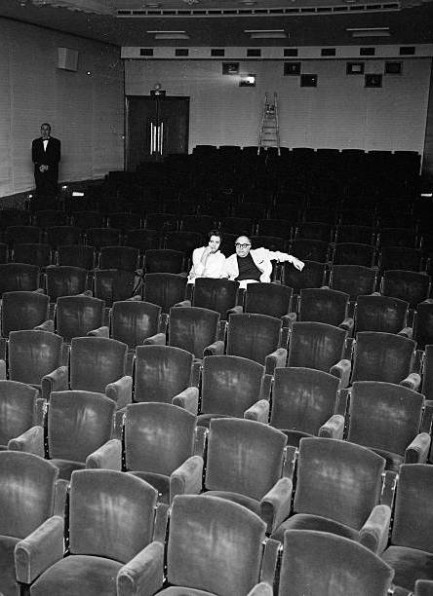 Sophia Loren sits with husband Carlo Ponti, who was a member of the 1966 Festival jury. Sophia Loren sits with husband Carlo Ponti, who was a member of the 1966 Festival jury.
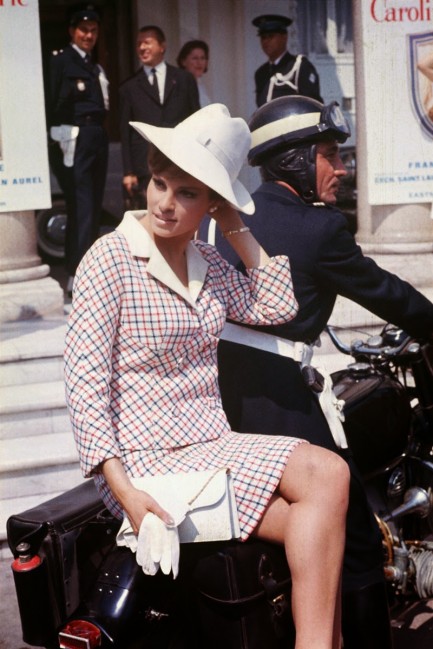 Raquel Welch poses on a motorcycle in 1966. Raquel Welch poses on a motorcycle in 1966.
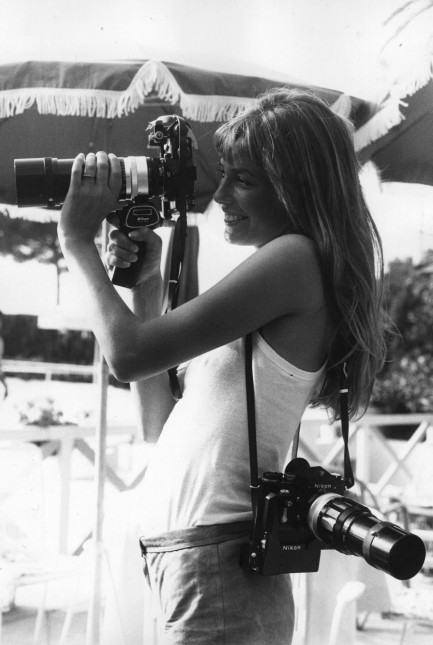 Jane Birkin takes aim with one of her cameras in 1975. Jane Birkin takes aim with one of her cameras in 1975. 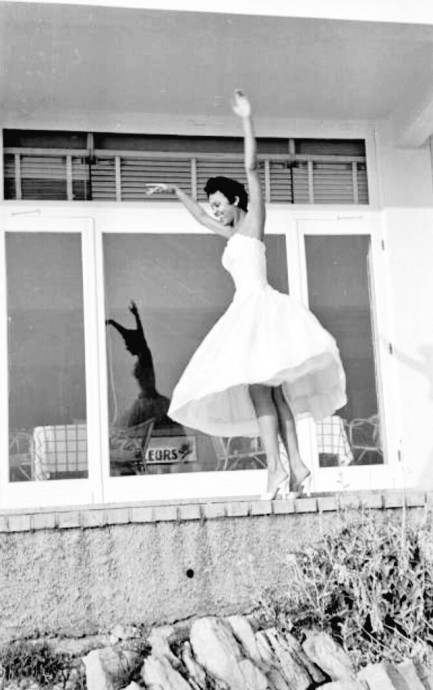 Dorothy Dandridge frolics in 1955, when she was promoting her film Carmen Jones. Dorothy Dandridge frolics in 1955, when she was promoting her film Carmen Jones.
 Cinematic icon Catherine Deneuve and her sister Françoise Dorléac in 1965. Dorléac died in an automobile accident a couple of years later. Cinematic icon Catherine Deneuve and her sister Françoise Dorléac in 1965. Dorléac died in an automobile accident a couple of years later. 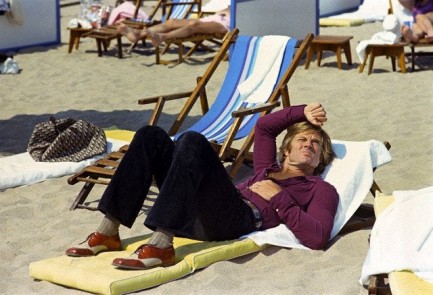 Robert Redford lounges on the beach in 1972. Based on his outfit you'd think he was in Cannes to promote The Sting, but he was actually there for his western Jeremiah Johnson, which screened May 7 of that year. Robert Redford lounges on the beach in 1972. Based on his outfit you'd think he was in Cannes to promote The Sting, but he was actually there for his western Jeremiah Johnson, which screened May 7 of that year.
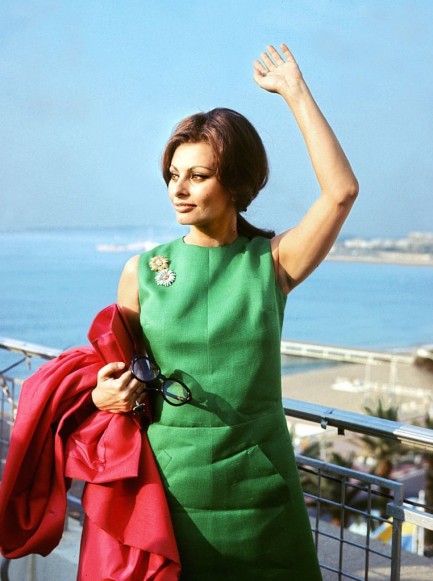 Sophia Loren waves to well-wishers in 1964. Sophia Loren waves to well-wishers in 1964.
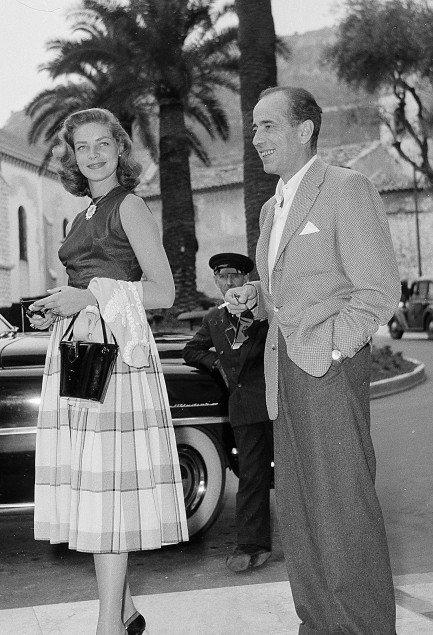 Bogie and Bacall paired up and looking distinguished in 1957. Bogie and Bacall paired up and looking distinguished in 1957.
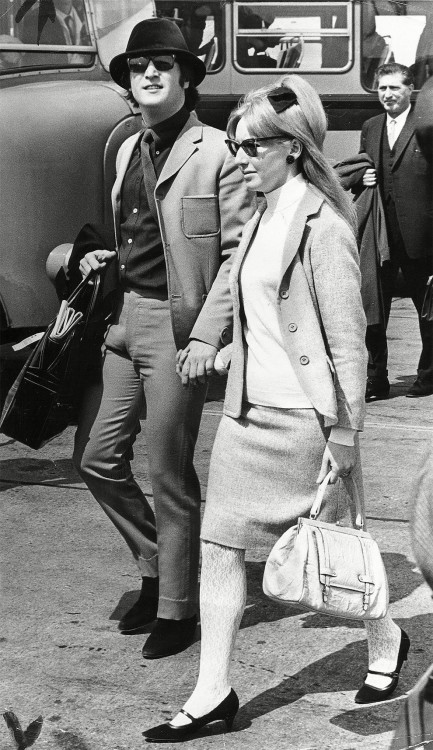 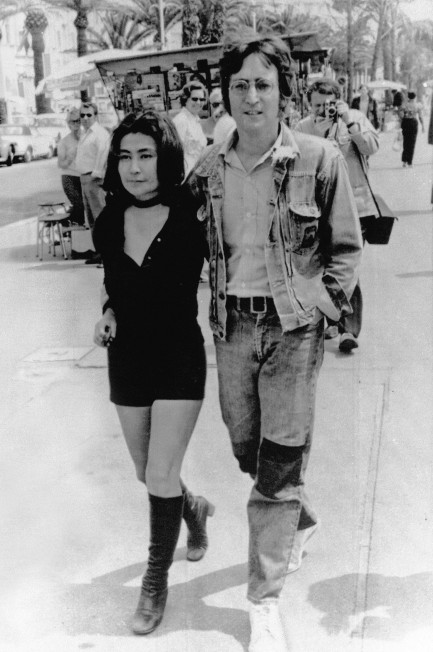 John and Cynthia Lennon in 1965, and John with Yoko Ono in 1971. Every story John told on that second trip probably started with, “When I was here with the first love of my life...” until Yoko smacked him across the mouth. John and Cynthia Lennon in 1965, and John with Yoko Ono in 1971. Every story John told on that second trip probably started with, “When I was here with the first love of my life...” until Yoko smacked him across the mouth.
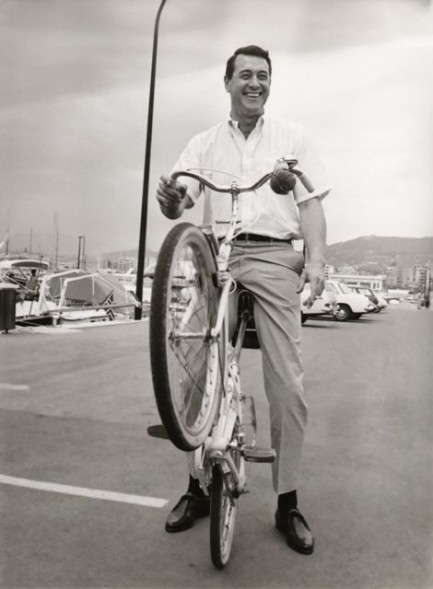 Rock Hudson and bicycle in 1966. Rock Hudson and bicycle in 1966.
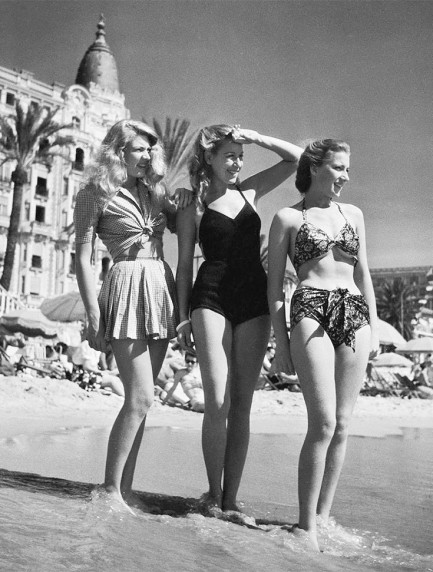 Unidentified actresses pose on the beach in 1947. To the rear is the Hotel Carlton, mentioned in the Edith Piaf image, built on the Croisette and finished in 1910. Unidentified actresses pose on the beach in 1947. To the rear is the Hotel Carlton, mentioned in the Edith Piaf image, built on the Croisette and finished in 1910.
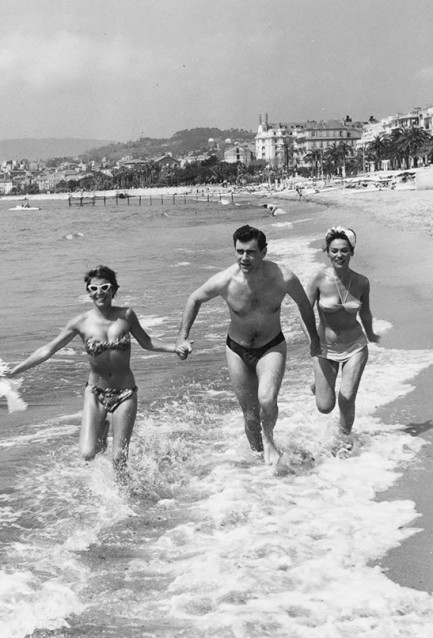 George Baker, Bella Darvi (right—your right, not his), and an unknown acquaintance have a surfside run/photo op in 1956. George Baker, Bella Darvi (right—your right, not his), and an unknown acquaintance have a surfside run/photo op in 1956.
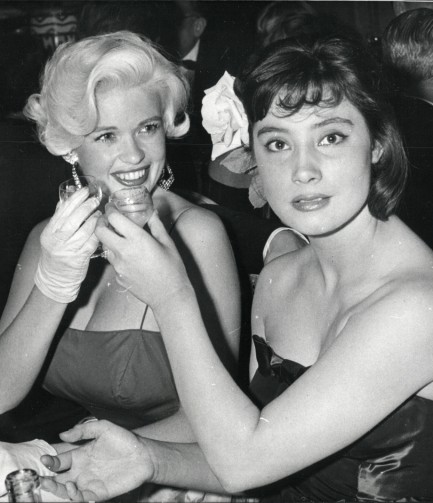 Jayne Mansfield and Russian actress Tatiana Samoïlova enjoy a toast in 1958. Mansfield probably shared the story of how she once made Sophia Loren stare at her boobs, and Samoïlova said, “Cheers to you—well played, you provocative American minx.” Jayne Mansfield and Russian actress Tatiana Samoïlova enjoy a toast in 1958. Mansfield probably shared the story of how she once made Sophia Loren stare at her boobs, and Samoïlova said, “Cheers to you—well played, you provocative American minx.”
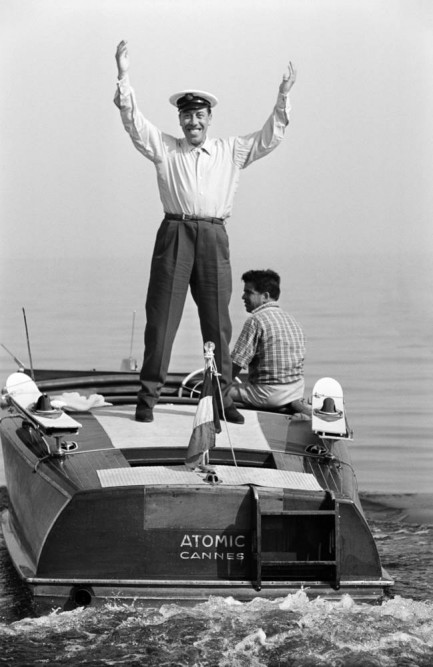 French actor Fernandel, whose real name was Fernand Contandin, on his boat Atomic in 1956. French actor Fernandel, whose real name was Fernand Contandin, on his boat Atomic in 1956.
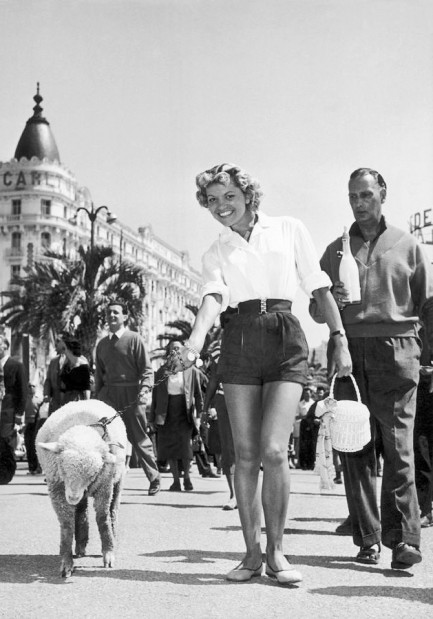 Arlette Patrick figures out a different way to generate publicity—by walking her sheep on the Croisette in 1955. Arlette Patrick figures out a different way to generate publicity—by walking her sheep on the Croisette in 1955.
 A pair of water skiers show perfect form in 1955, as a battleship floats in the background. A pair of water skiers show perfect form in 1955, as a battleship floats in the background.
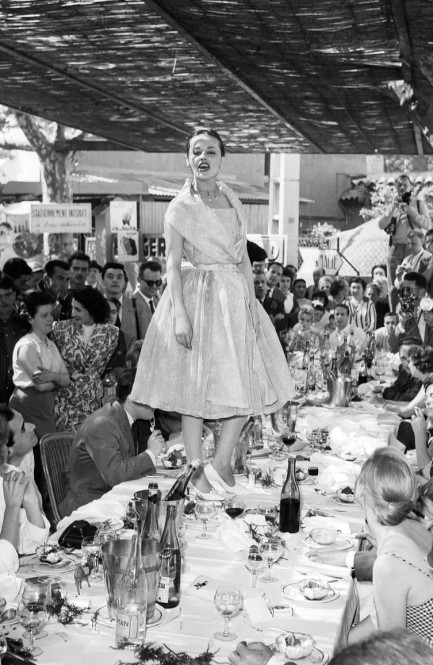 Jeanne Moreau, for reasons that are unclear, poses on a banquet table in 1958. Most sources descibe this in such a way as to make it seem spontaneous, but we have our doubts. It's a great shot, though. Jeanne Moreau, for reasons that are unclear, poses on a banquet table in 1958. Most sources descibe this in such a way as to make it seem spontaneous, but we have our doubts. It's a great shot, though.
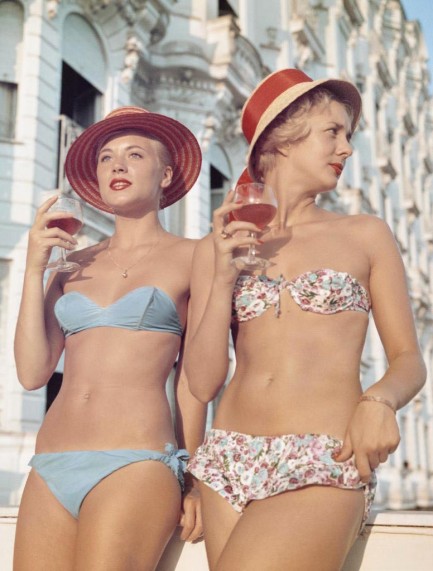 Two unidentified women take in the scene from the terrace of the Hotel Carlton, 1958. This shot is usually said to portray two tourists, but the woman on the left is the same person as in the bikini lunch shot from earlier, which tells us she's a model or actress, and both photos are staged. Like we said, publicity is everything in Cannes. Two unidentified women take in the scene from the terrace of the Hotel Carlton, 1958. This shot is usually said to portray two tourists, but the woman on the left is the same person as in the bikini lunch shot from earlier, which tells us she's a model or actress, and both photos are staged. Like we said, publicity is everything in Cannes. 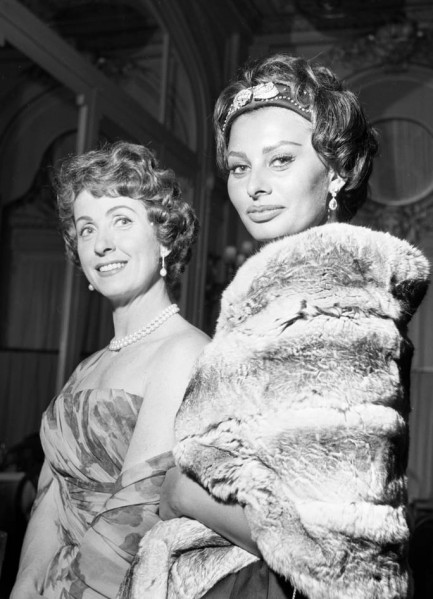 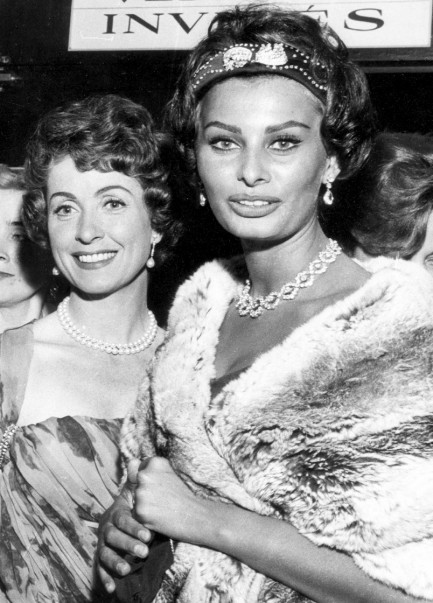 Danielle Darrieux and Sophia Loren at the 11th Cannes Film Festival, 1958. Danielle Darrieux and Sophia Loren at the 11th Cannes Film Festival, 1958.
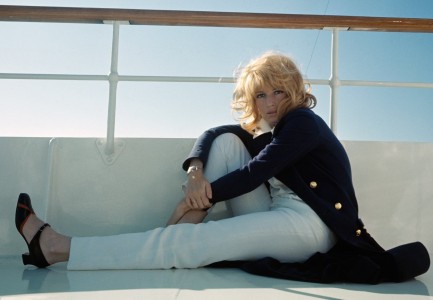 Italian actress Monica Vitti chills on a boat in 1968. Italian actress Monica Vitti chills on a boat in 1968.
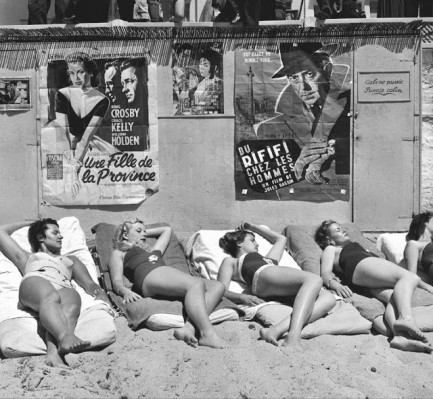 Aspiring stars catch some rays on the Croisette beach in 1955. The two large posters behind them are for The Country Girl with Grace Kelly, and Jules Dassin's Du rififi chez les hommes, both below. Aspiring stars catch some rays on the Croisette beach in 1955. The two large posters behind them are for The Country Girl with Grace Kelly, and Jules Dassin's Du rififi chez les hommes, both below.
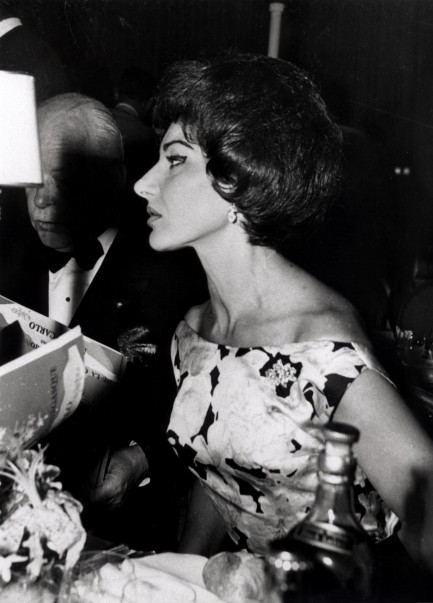 The renowned opera singer Maria Callas, 1960. The renowned opera singer Maria Callas, 1960.
 Big screen Thief gets the job done but isn't quite the perfect crime. 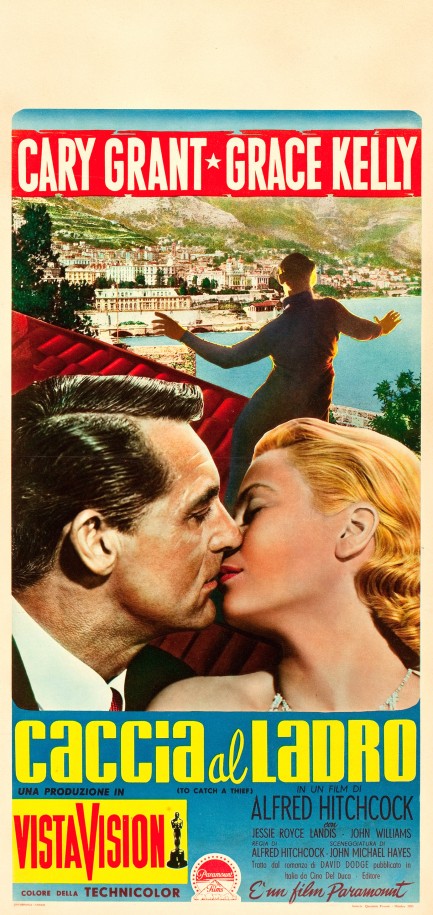
This is a spectacular Italian poster for Caccia al ladro, aka To Catch a Thief, with Cary Grant and Grace Kelly. The moviemakers opted for a photo-illustration rather than a painting, and it befits the star power of the movie. It was based on David Dodge's best seller of the same name, and in truth it's a pretty simple-minded adaptation of the book. You can just hear the studio execs saying: “We know it's in the novel, but we can't have the star in disguise half the movie, we can't have the romance go unacknowledged until the final reel, and we for damn sure can't have the secondary female lead be more beautiful than Grace Kelly.” Movies are a different medium than books, and changes always happen, but it's just interesting to observe what those changes are. The main change is this: Dodge's novel has suspense, while Hitchcock's adaptation does not. That probably wasn't intentional.
To Catch a Thief is a superstar vehicle, and with Grant and Kelly in the lead roles, and Hitchcock in the director's chair, it's pretty clear the studio considered the hard work done. Extensive French Riviera location shooting and VistaVision widescreen film processing are nice bonuses, but the honchos should have had screenwriter John Michael Hayes hammer the script out a little smoother. We're not being iconoclasts here. The movie received mixed reviews upon release, with some important critics calling it a failure. That's going too far—it isn't a failure. We don't think Grant, Kelly, and Hitchcock would have been capable of making anything but a good movie at this stage. But considering the source material it could have been a perfect movie. To Catch a Thief premiered in the U.S in early August 1955, and in Italy at the Venice Film Festival today the same year. 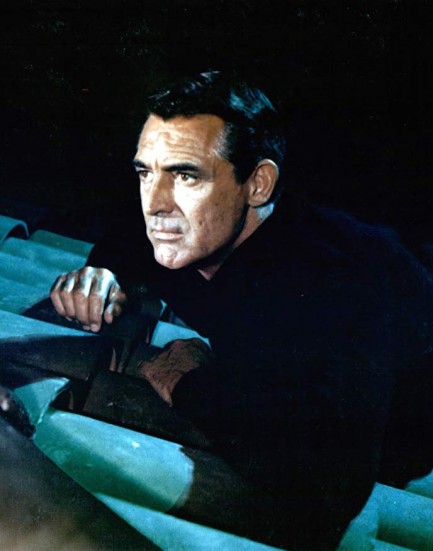 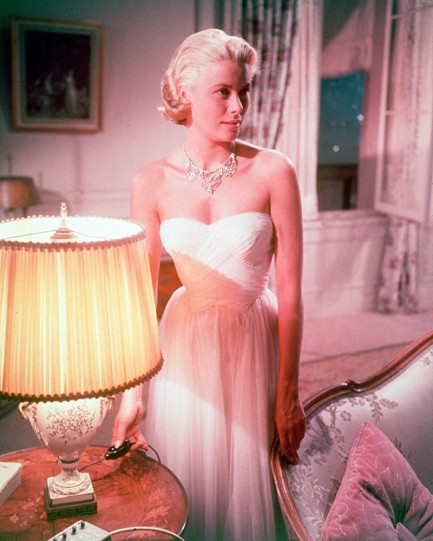 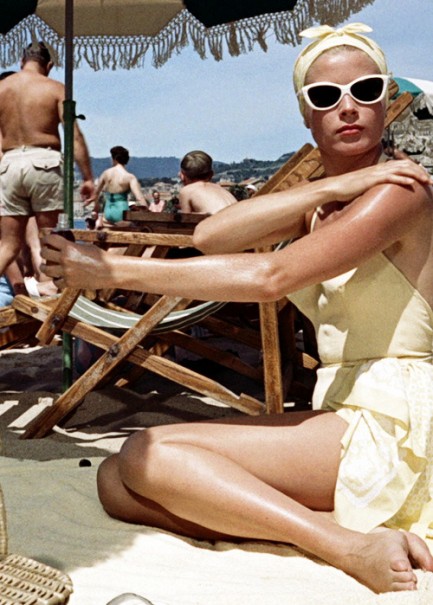 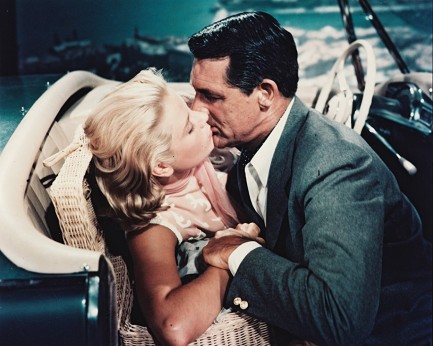 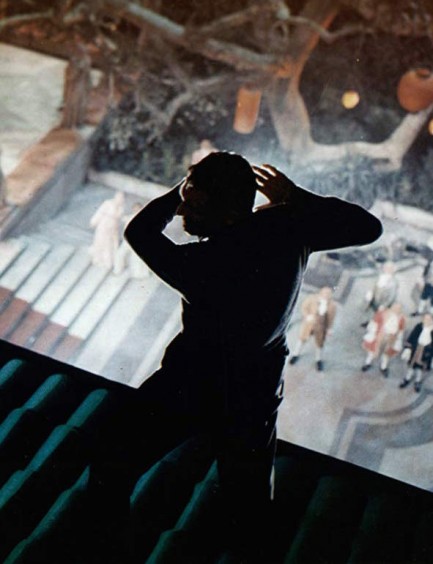 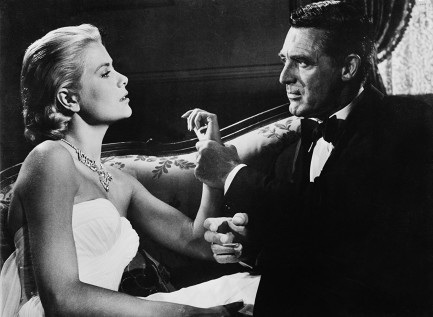 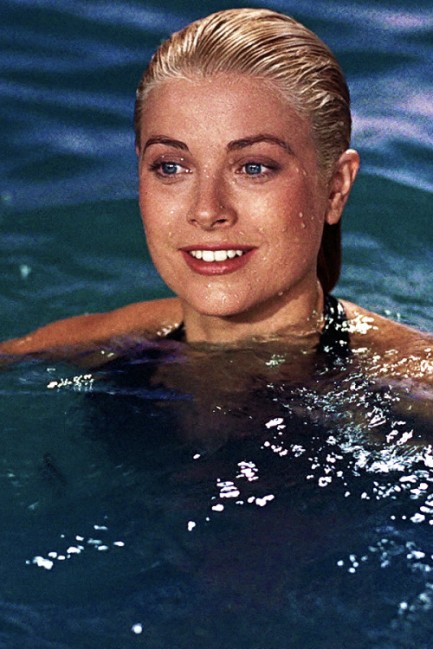 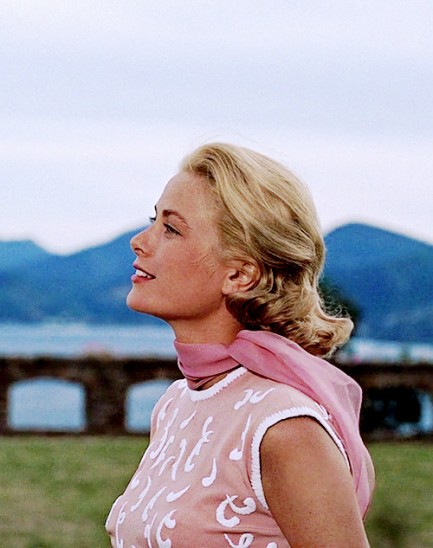 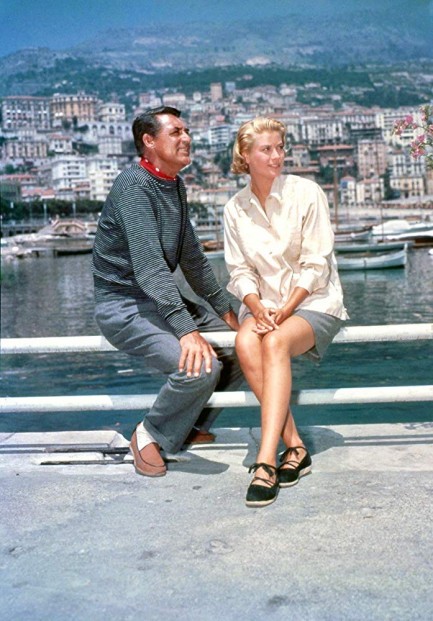 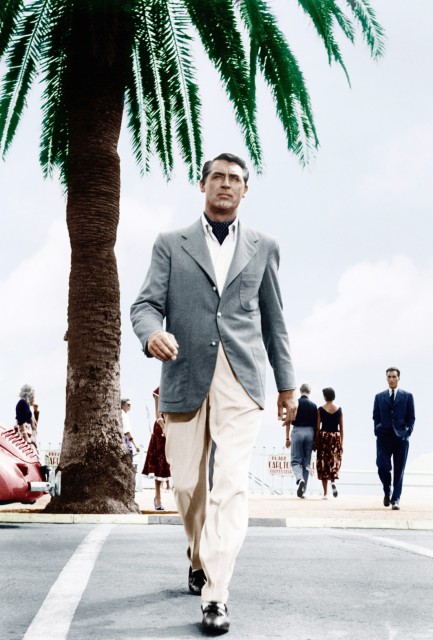

|
 |

The headlines that mattered yesteryear.
2003—Hope Dies
Film legend Bob Hope dies of pneumonia two months after celebrating his 100th birthday. 1945—Churchill Given the Sack
In spite of admiring Winston Churchill as a great wartime leader, Britons elect
Clement Attlee the nation's new prime minister in a sweeping victory for the Labour Party over the Conservatives. 1952—Evita Peron Dies
Eva Duarte de Peron, aka Evita, wife of the president of the Argentine Republic, dies from cancer at age 33. Evita had brought the working classes into a position of political power never witnessed before, but was hated by the nation's powerful military class. She is lain to rest in Milan, Italy in a secret grave under a nun's name, but is eventually returned to Argentina for reburial beside her husband in 1974. 1943—Mussolini Calls It Quits
Italian dictator Benito Mussolini steps down as head of the armed forces and the government. It soon becomes clear that Il Duce did not relinquish power voluntarily, but was forced to resign after former Fascist colleagues turned against him. He is later installed by Germany as leader of the Italian Social Republic in the north of the country, but is killed by partisans in 1945.
|

|
|

It's easy. We have an uploader that makes it a snap. Use it to submit your art, text, header, and subhead. Your post can be funny, serious, or anything in between, as long as it's vintage pulp. You'll get a byline and experience the fleeting pride of free authorship. We'll edit your post for typos, but the rest is up to you. Click here to give us your best shot.

|
|





































































































 If you'd had sex with me I wouldn't be out here with the pigeons right now.
If you'd had sex with me I wouldn't be out here with the pigeons right now. Headquarters? Do not—I repeat do not—eat all the donuts. We'll get this nutjob off the ledge and be back there as quick as we can.
Headquarters? Do not—I repeat do not—eat all the donuts. We'll get this nutjob off the ledge and be back there as quick as we can. I certainly don't want you to get desperate enough to climb onto a ledge. Let's go to your place and I'll show you what life is all about.
I certainly don't want you to get desperate enough to climb onto a ledge. Let's go to your place and I'll show you what life is all about. Don't jump, son! Without you there'll be nobody around to listen to me complain about what a loser your father is!
Don't jump, son! Without you there'll be nobody around to listen to me complain about what a loser your father is! Hello, headquarters? Status check on those donuts.
Hello, headquarters? Status check on those donuts. Just cooperate, mister! There are a lot of hungry cops up here!
Just cooperate, mister! There are a lot of hungry cops up here!




 Edith Piaf sings on the terrace of the Carlton Hotel on the iconic Boulevard de la Croisette at the first Festival de Cannes to be held under that name, in 1946. Back then the event took place in September and October, but would shift to May a bit later.
Edith Piaf sings on the terrace of the Carlton Hotel on the iconic Boulevard de la Croisette at the first Festival de Cannes to be held under that name, in 1946. Back then the event took place in September and October, but would shift to May a bit later.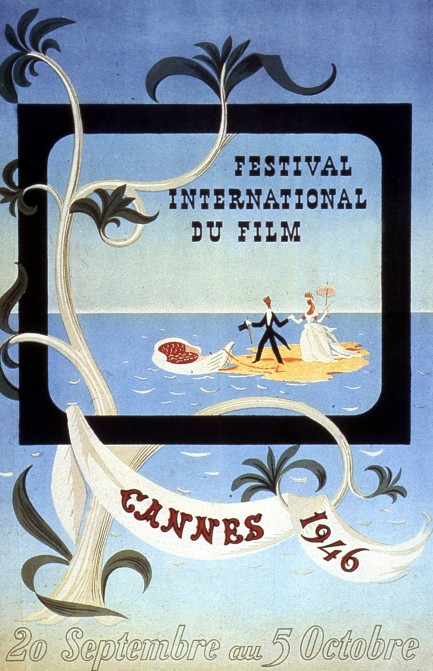
 Diana Dors and Ginger Rogers arrive at the fest the only way anyone should—breezing along the beachfront in a convertible, in 1956, with an unknown driver.
Diana Dors and Ginger Rogers arrive at the fest the only way anyone should—breezing along the beachfront in a convertible, in 1956, with an unknown driver. Kirk Douglas holds court on the beach in 1953, and Brigitte Bardot soaks up rays in the foreground.
Kirk Douglas holds court on the beach in 1953, and Brigitte Bardot soaks up rays in the foreground. Michele Morgan poses at the first Festival in 1946. Photo ops of this sort were essential sources of publicity for stars, and would soon become opportunities for non-stars seeking to be discovered.
Michele Morgan poses at the first Festival in 1946. Photo ops of this sort were essential sources of publicity for stars, and would soon become opportunities for non-stars seeking to be discovered. Case in point. Robert Mitchum poses with actress Simone Sylva in 1954. Sylva was allegedly not supposed to be there, but shucked her top and photo-bombed Douglas in an attempt to raise her profile. It didn't work. She made only a couple of credited movie appearances after her topless stunt.
Case in point. Robert Mitchum poses with actress Simone Sylva in 1954. Sylva was allegedly not supposed to be there, but shucked her top and photo-bombed Douglas in an attempt to raise her profile. It didn't work. She made only a couple of credited movie appearances after her topless stunt. Romy Schneider and Alain Delon at the 1959 fest.
Romy Schneider and Alain Delon at the 1959 fest. An unidentified model or actress poses in the style of Anita Ekberg from La dolce vita in 1960. This looks like it was shot at Plage du Midi, which is a beach located a little ways west of the Cannes town center.
An unidentified model or actress poses in the style of Anita Ekberg from La dolce vita in 1960. This looks like it was shot at Plage du Midi, which is a beach located a little ways west of the Cannes town center. A unidentified partygoer is tossed into a swimming pool after La Dolce Vita won the the 1960 Palme d’Or. The Festival is almost as well known for legendary parties as for legendary film premieres.
A unidentified partygoer is tossed into a swimming pool after La Dolce Vita won the the 1960 Palme d’Or. The Festival is almost as well known for legendary parties as for legendary film premieres.
 Another unidentified model or actress poses on the boardwalk in 1979. Generally, you don't have to be known to draw a crowd of photographers—you just have to be nearly bare. She's wearing lingerie, so that explains the interest, though this is modest garb for a Cannes publicity stunt. It's never a surprise to see a headline-seeking film hopeful strip all the way down to a string ficelle féminin, or thong, which is the limit of what is legal in Cannes
Another unidentified model or actress poses on the boardwalk in 1979. Generally, you don't have to be known to draw a crowd of photographers—you just have to be nearly bare. She's wearing lingerie, so that explains the interest, though this is modest garb for a Cannes publicity stunt. It's never a surprise to see a headline-seeking film hopeful strip all the way down to a string ficelle féminin, or thong, which is the limit of what is legal in Cannes Sidney Poitier and Jean Seberg have a laugh in 1961. This was the year Poitier's flick Paris Blues was released, so it's possible he had jetted down from the capital for the Festival.
Sidney Poitier and Jean Seberg have a laugh in 1961. This was the year Poitier's flick Paris Blues was released, so it's possible he had jetted down from the capital for the Festival. Philomène Toulouse relaxes on the sand in 1962 while a boy practices the classic French look of disgust he'll be using the rest of his life.
Philomène Toulouse relaxes on the sand in 1962 while a boy practices the classic French look of disgust he'll be using the rest of his life. Actor Bernard Blier, 1975.
Actor Bernard Blier, 1975. An unidentified bikini wearer boldly enjoys a lunch in a café on the Croisette, 1958.
An unidentified bikini wearer boldly enjoys a lunch in a café on the Croisette, 1958. Natalie Wood aboard a sailboat in 1962.
Natalie Wood aboard a sailboat in 1962.
 Grace Kelly, 1955.
Grace Kelly, 1955. Kelly times two—Grace Kelly and Gene Kelly, hanging out, also in 1955.
Kelly times two—Grace Kelly and Gene Kelly, hanging out, also in 1955. Sammy Davis, Jr. poses in front of a billboard promoting his film A Man Called Adam, 1966.
Sammy Davis, Jr. poses in front of a billboard promoting his film A Man Called Adam, 1966. Joan Scott gets sand between her toes in 1955. Scott is obscure. She isn't even the most famous Joan Scott anymore. The IMDB entry for the only Joan Scott near the appropriate age is for an actress born in 1920 who didn't begin acting until 1967. The Joan Scott above doesn't look thirty-five, though, and we doubt she would have been the subject of this somewhat well-known photo without parlaying it into a film appearance before twelve years had passed. So we don't think this is the Joan Scott referenced on IMDB.
Joan Scott gets sand between her toes in 1955. Scott is obscure. She isn't even the most famous Joan Scott anymore. The IMDB entry for the only Joan Scott near the appropriate age is for an actress born in 1920 who didn't begin acting until 1967. The Joan Scott above doesn't look thirty-five, though, and we doubt she would have been the subject of this somewhat well-known photo without parlaying it into a film appearance before twelve years had passed. So we don't think this is the Joan Scott referenced on IMDB.
 Sharon Tate, with Roman Polanski, and solo, 1968.
Sharon Tate, with Roman Polanski, and solo, 1968. Marlene Dietrich brings glamour to a tiki themed bar in 1958.
Marlene Dietrich brings glamour to a tiki themed bar in 1958.
 Tippi Hedren and Alfred Hitchcock release caged birds as a promo stunt for The Birds in 1963.
Tippi Hedren and Alfred Hitchcock release caged birds as a promo stunt for The Birds in 1963. Sophia Loren sits with husband Carlo Ponti, who was a member of the 1966 Festival jury.
Sophia Loren sits with husband Carlo Ponti, who was a member of the 1966 Festival jury. Raquel Welch poses on a motorcycle in 1966.
Raquel Welch poses on a motorcycle in 1966. Jane Birkin takes aim with one of her cameras in 1975.
Jane Birkin takes aim with one of her cameras in 1975. Dorothy Dandridge frolics in 1955, when she was promoting her film Carmen Jones.
Dorothy Dandridge frolics in 1955, when she was promoting her film Carmen Jones. Cinematic icon Catherine Deneuve and her sister Françoise Dorléac in 1965. Dorléac died in an automobile accident a couple of years later.
Cinematic icon Catherine Deneuve and her sister Françoise Dorléac in 1965. Dorléac died in an automobile accident a couple of years later. Robert Redford lounges on the beach in 1972. Based on his outfit you'd think he was in Cannes to promote The Sting, but he was actually there for his western Jeremiah Johnson, which screened May 7 of that year.
Robert Redford lounges on the beach in 1972. Based on his outfit you'd think he was in Cannes to promote The Sting, but he was actually there for his western Jeremiah Johnson, which screened May 7 of that year. Sophia Loren waves to well-wishers in 1964.
Sophia Loren waves to well-wishers in 1964. Bogie and Bacall paired up and looking distinguished in 1957.
Bogie and Bacall paired up and looking distinguished in 1957.
 John and Cynthia Lennon in 1965, and John with Yoko Ono in 1971. Every story John told on that second trip probably started with, “When I was here with the first love of my life...” until Yoko smacked him across the mouth.
John and Cynthia Lennon in 1965, and John with Yoko Ono in 1971. Every story John told on that second trip probably started with, “When I was here with the first love of my life...” until Yoko smacked him across the mouth. Rock Hudson and bicycle in 1966.
Rock Hudson and bicycle in 1966. Unidentified actresses pose on the beach in 1947. To the rear is the Hotel Carlton, mentioned in the Edith Piaf image, built on the Croisette and finished in 1910.
Unidentified actresses pose on the beach in 1947. To the rear is the Hotel Carlton, mentioned in the Edith Piaf image, built on the Croisette and finished in 1910. George Baker, Bella Darvi (right—your right, not his), and an unknown acquaintance have a surfside run/photo op in 1956.
George Baker, Bella Darvi (right—your right, not his), and an unknown acquaintance have a surfside run/photo op in 1956. Jayne Mansfield and Russian actress Tatiana Samoïlova enjoy a toast in 1958. Mansfield probably shared the story of how she once made Sophia Loren stare at her boobs, and Samoïlova said, “Cheers to you—well played, you provocative American minx.”
Jayne Mansfield and Russian actress Tatiana Samoïlova enjoy a toast in 1958. Mansfield probably shared the story of how she once made Sophia Loren stare at her boobs, and Samoïlova said, “Cheers to you—well played, you provocative American minx.” French actor Fernandel, whose real name was Fernand Contandin, on his boat Atomic in 1956.
French actor Fernandel, whose real name was Fernand Contandin, on his boat Atomic in 1956. Arlette Patrick figures out a different way to generate publicity—by walking her sheep on the Croisette in 1955.
Arlette Patrick figures out a different way to generate publicity—by walking her sheep on the Croisette in 1955. A pair of water skiers show perfect form in 1955, as a battleship floats in the background.
A pair of water skiers show perfect form in 1955, as a battleship floats in the background. Jeanne Moreau, for reasons that are unclear, poses on a banquet table in 1958. Most sources descibe this in such a way as to make it seem spontaneous, but we have our doubts. It's a great shot, though.
Jeanne Moreau, for reasons that are unclear, poses on a banquet table in 1958. Most sources descibe this in such a way as to make it seem spontaneous, but we have our doubts. It's a great shot, though. Two unidentified women take in the scene from the terrace of the Hotel Carlton, 1958. This shot is usually said to portray two tourists, but the woman on the left is the same person as in the bikini lunch shot from earlier, which tells us she's a model or actress, and both photos are staged. Like we said, publicity is everything in Cannes.
Two unidentified women take in the scene from the terrace of the Hotel Carlton, 1958. This shot is usually said to portray two tourists, but the woman on the left is the same person as in the bikini lunch shot from earlier, which tells us she's a model or actress, and both photos are staged. Like we said, publicity is everything in Cannes.
 Danielle Darrieux and Sophia Loren at the 11th Cannes Film Festival, 1958.
Danielle Darrieux and Sophia Loren at the 11th Cannes Film Festival, 1958. Italian actress Monica Vitti chills on a boat in 1968.
Italian actress Monica Vitti chills on a boat in 1968. Aspiring stars catch some rays on the Croisette beach in 1955. The two large posters behind them are for The Country Girl with Grace Kelly, and Jules Dassin's Du rififi chez les hommes, both below.
Aspiring stars catch some rays on the Croisette beach in 1955. The two large posters behind them are for The Country Girl with Grace Kelly, and Jules Dassin's Du rififi chez les hommes, both below.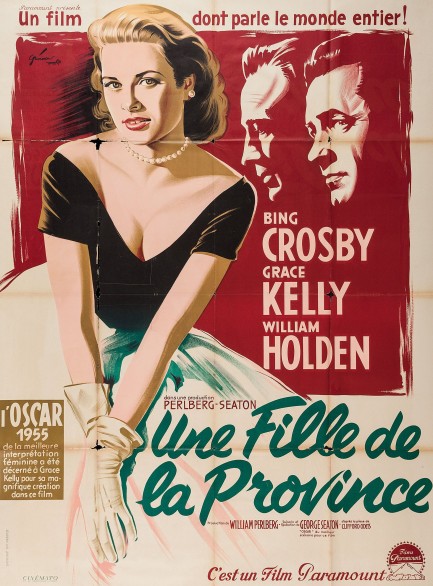
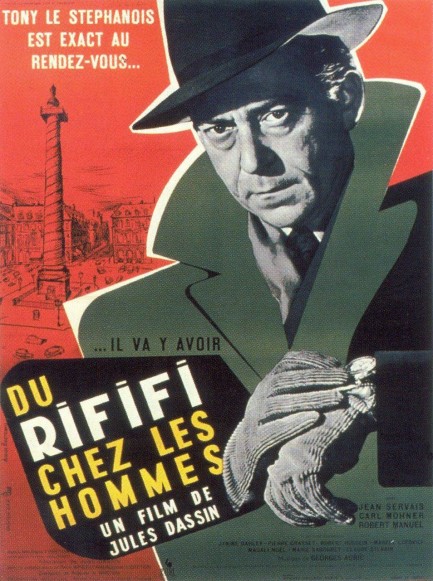
 The renowned opera singer Maria Callas, 1960.
The renowned opera singer Maria Callas, 1960.
















































































